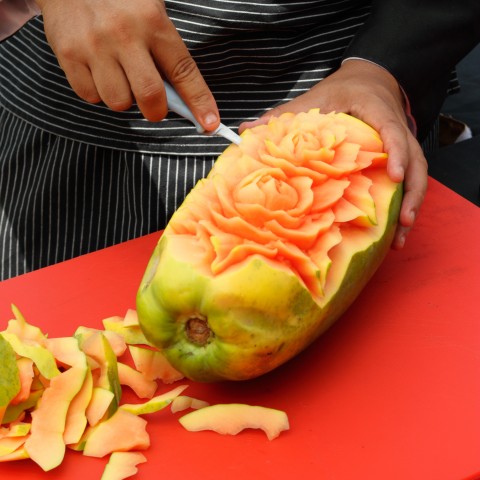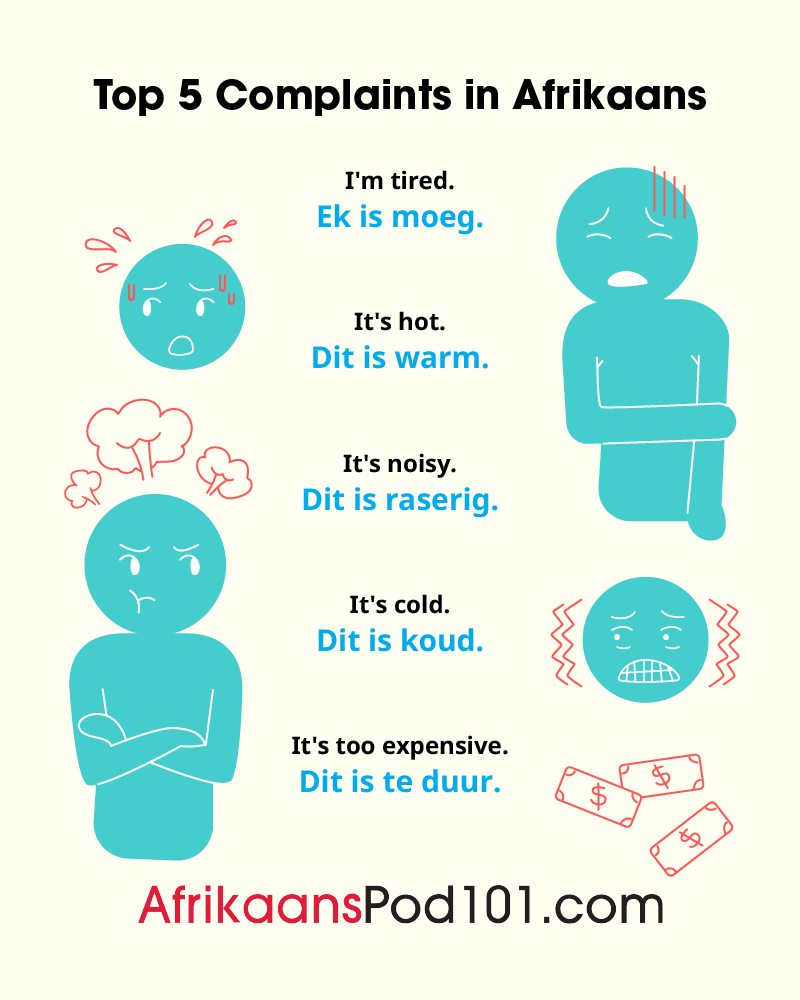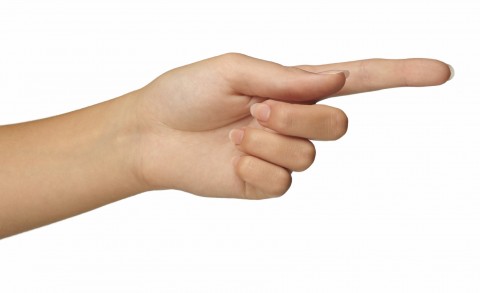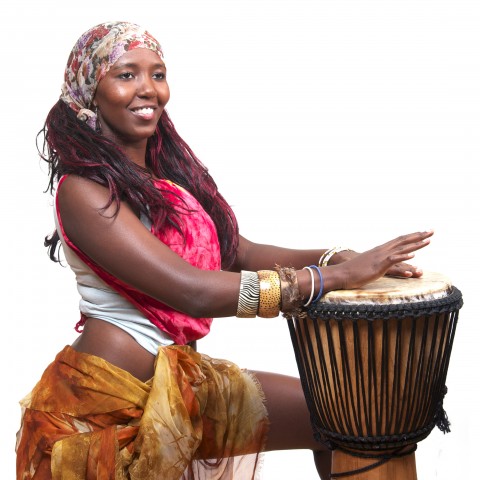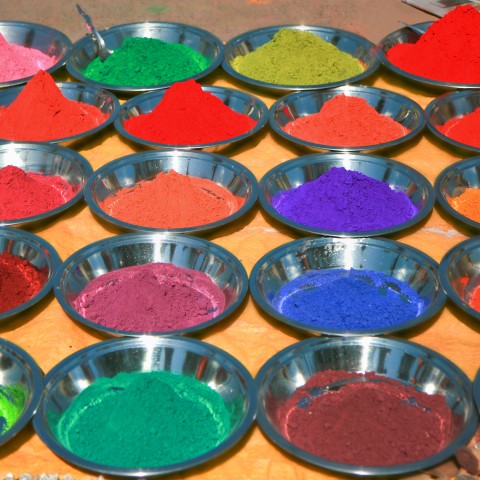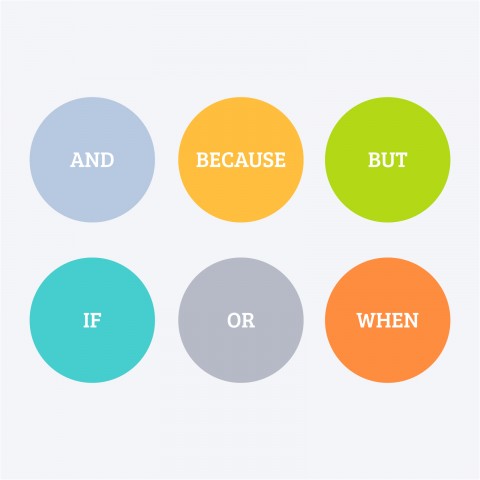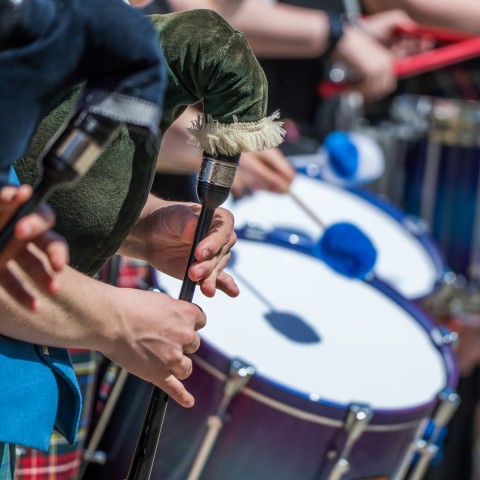
Word order, or syntax, in any language is often a challenging thing to master, and Afrikaans is no exception. But once you’re familiar with the most basic Afrikaans sentence structure rules, you’ll find that the rest comes with less difficulty. At AfrikaansPod101.com, we know how to make it easy for you, so with a bit of effort, you’ll have Afrikaans word order under your belt in no time!
 Table of Contents
Table of Contents
- Structural Patterns in Languages
- Afrikaans Sentence Structure Rules
- STOMPI
- Explanation of the Sentence Elements in Sv1TOMPv2I
- More Examples of the Basic Afrikaans Sentence Structure: STOMPI
- Why AfrikaansPod101 is the Best Choice to Learn Afrikaans Sentence Structures!
1. Structural Patterns in Languages

To briefly explain what we’re looking at: In linguistic typology as a field of study, the structural and functional features of all languages are studied and compared.
Syntactic typology, dealing with the order, form, grammar, and choice of words, is a subset of this discipline, and is also the one we’re dealing with here.
In the largest number of languages in the world, all of the simplest, most basic statement sentences have the following word order pattern:
1) Subject: I
2) Object: Afrikaans
3) Verb: study.
Or: “I Afrikaans study.” (Obviously, neither English nor Afrikaans follow this pattern!)
This Subject – Object – Verb (SOV) sentence pattern or word order gets used in languages such as Japanese, Korean, Mongolian, Turkish, Hindi, Bengali, Punjabi, the Dravidian languages, and more.
Other structural patterns in language include:
- Subject – Verb – Object (SVO)
- Verb – Object – Subject (VOS)
Many synthetic languages (including Latin, Greek, Persian, Romanian, Assyrian, Russian, Turkish, Korean, Japanese, Finnish, and Basque) have no strict word order. Rather, the sentence structure is flexible and reflects the practical aspects of what’s being said, according to Wikipedia.
In this sense, then, word order in Afrikaans follows the SVO pattern, meaning that the most basic statement sentence will always look like this:
1) Subject: Ek (I)
2) Verb: studeer (study)
3) Object: Afrikaans. (Afrikaans.)
Ek studeer Afrikaans. (“I study Afrikaans.”)
or
1) Subject: Ek (I)
2) Verb: hou (like)
3) Object: daarvan. (it.)
Ek hou daarvan. (“I like it.”)
If you can manage to remember this, you’ve covered a lot! Also, English follows the same pattern for many basic statement sentences.

2. Afrikaans Sentence Structure Rules
There’s only one rule concerning Afrikaans sentences – no matter the type of sentence, the first verb, or Verb 1, will always take the second place.
Except for two types of sentences: questions starting with a verb and commands.
Here are some samples. Notice the position of Verb 1.
Questions Starting with a Verb and Command Sentences
| Question Sentences | Translation | Command Sentences | Translation |
|---|---|---|---|
| Eet die man vinnig? | “Eats the man fast?” / “Does the man eat fast?” | Eet vinniger! | “Eat faster!” |
| Skenk hulle geld? | “Donate they money?” / “Do they donate money?” | Skenk die geld, asseblief. | “Donate the money, please.” |
| Oefen jy jou Afrikaans? | Lit. “Practice you your Afrikaans?” / “Do you practice your Afrikaans” | Oefen nou jou Afrikaans. | “Practice your Afrikaans now.” |
Not too difficult, right? And it gets easier – all because of STOMPI.
3. STOMPI
Afrikaans sentence structure is most often illustrated with this acronym, which is very commonly used in language studies. If you’ve been studying Afrikaans sentence structure rules at all, then you’ve probably encountered the famous STOMPI by now.
It stands for the different parts of the sentence:
Subject
Time
Object
Manner
Place
Infinitive
Note: A stompie in Afrikaans means “short” or “a little piece of.” We also use it to refer to a cigarette butt. Or a really short person. Cute, hey?
If this format seems to lack a thing or two, don’t worry. We use STOMPI because the word falls nicely on the tongue, making it easy to remember! But you’re right—where are the verbs in this format?
The complete format looks like this:
Subject
V1 – Verb 1 (Some call this the Invisible Verb 1!)
Time
Object
Manner
Place
V2 – Verb 2 (And this is the Invisible Verb 2.)
Infinitive
Note: Not all sentences contain all the elements. That would be a much-expanded sentence. However, the acronym is helpful because it shows you exactly where the elements belong, no matter which you use in your sentence.
4. Explanation of the Sentence Elements in Sv1TOMPv2I
Before we proceed to look at how STOMPI is employed in Afrikaans, let’s recap what the different elements mean.
1) SUBJECT:
- The subject is what the sentence is all about.
- It’s the answer to the question “Who?” or “What?”
- The subject is usually found at the beginning of the sentence.
Types of Words Used:
Nouns, proper nouns, pronouns, and articles.
Example:
Die kinders het altyd die rekenaarspeletjie luidrugtig in die kamer gespeel om te ontspan.
Lit: “The children always played the computer game loudly in the room to relax.”
2) VERB 1:
- It’s called “Verb 1” because it’s the first verb of the sentence.
- All Verb 1s fall into one of two groups:
- 1) Present Tense: Here, Verb 1 is the main and only verb in the sentence.
- 2) Past and Future Tenses: Here, Verb 1 is always a helping verb or a hulpwerkwoord.
Samples of Afrikaans Helping Verbs:
Past tenses: het, wou, sou, kon, moes (“have/has, would, could, should have”)
Future tenses: sal, wil, kan, moet (“shall, will, can, must”)
Example:
Die kinders het altyd die rekenaarspeletjie luidrugtig in die kamer gespeel om te ontspan.
(No English translation for the simple past tense het.)

3) TIME:
- This word or phrase is always the answer to the question “When?”
Types of Words/Phrases Used:
Adverbs of time such as gister (“yesterday”); more (“tomorrow”); elke dag (“every day”); gewoonlik / (“usually”); oor tien minute / (“in ten minutes”); etc.
Example:
Die kinders het altyd die rekenaarspeletjie luidrugtig in die kamer gespeel om te ontspan.
“The children always played the computer game loudly in the room to relax.”
4) OBJECT:
- This word or phrase can be identified as the thing upon which the action (indicated by the verb) is transferred. For instance, in a sentence such as “The boy kicks the ball,” the ball is the object. This is because the boy is performing an action (kicking) on the ball. Or, the ball is the receiver of the action, so to speak.
- Sometimes the subject and the object can look the same, depending on what voice is used: Passive or Active.
Types of Words/Phrases Used:
Nouns, pronouns, and articles.
Example:
Die kinders het altyd die rekenaarspeletjie luidrugtig in die kamer gespeel om te ontspan.
“The children always played the computer game loudly in the room to relax.”
5) MANNER:
- This is the word or phrase that answers the question: “How?”
- Manner words can have degrees of comparison (e.g. “hard – harder – hardest”).
Types of Words Used:
This is always an adverb, as it describes Verb 1 or 2 (i.e. the action).
Example:
Die kinders het altyd die rekenaarspeletjie luidrugtig in die kamer gespeel om te ontspan.
“The children always played the computer game loudly in the room to relax.”
6) PLACE:
- The word or clause you can answer the question “Where?” with is your place word.
- The place word is always accompanied by a preposition (voorsetsel) such as in (“in”), agter (“behind”), voor (“in front” OR “ahead of”), oor (“over”), bo-op (“on top of”), onder (“under”), etc.
Types of Words Used:
Prepositions + articles, pronouns, and nouns.
Example:
Die kinders het altyd die rekenaarspeletjie luidrugtig in die kamer gespeel om te ontspan.
“The children always played the computer game loudly in the room to relax.”
7) VERB 2:
- No present tense sentence contains a second verb.
- Only the future and past tenses have a Verb 2, which is always the main verb.
- In the past and some future tense sentences, this verb is always conjugated with the prefix ge–.
Example:
Die kinders het altyd die rekenaarspeletjie luidrugtig in die kamer gespeel om te ontspan.
“The children always played the computer game loudly in the room to relax.”
(Read about Afrikaans verb conjugation in this blog post!)
8) INFINITIVE:
- The infinitive is always a phrase in Afrikaans, and it’s the easiest to identify.
- It answers the question “Why?” as it explains the reason for the action taken.
Types of Words Used:
Always includes the words om te (“to”) in some way. In addition: articles, nouns, pronouns, adjectives, and verbs.
Example:
Die kinders het altyd die rekenaarspeletjie luidrugtig in die kamer gespeel om te ontspan.“The children always played the computer game loudly in the room to relax.”
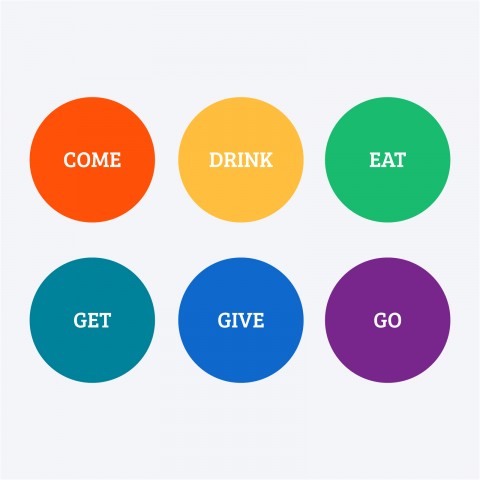
Easy, isn’t it? Using the acronyms mentioned under A above, see if you can spot the sentence structure now. Then post it in the comments!
5. More Examples of the Basic Afrikaans Sentence Structure: STOMPI

When you start sentences with different words, the basic Afrikaans sentence structure (and type!) is modified, but not a lot. In these columns, you should be able to see this very clearly.
Note, however, how Verb 1 is ALWAYS in the second place.
| TENSES | Subject | verb1 | Time | Object | Manner | Place | verb2 | Infinitives |
|---|---|---|---|---|---|---|---|---|
| STARTING WITH THE SUBJECT – Sv1TOMPv2I | ||||||||
| Present | Die vlieënier The pilot | vlieg flies | elke dag every day | met die vliegtuig with the airplane | hoog high | in die lug in the air | / / | om sy werk te doen. to do his job. |
| Past | Die vlieënier The pilot | het / | elke dag every day | met die vliegtuig with the airplane | hoog high | in die lug in the air | gevlieg flew | om sy werk te doen. to do his job. |
| Future | Die vlieënier The pilot | sal will | elke dag every day | met die vliegtuig with the airplane | hoog high | in die lug in the air | vlieg fly | om sy werk te doen. to do his job. |
| TENSES | Time | verb1 | Subject | Object | Manner | Place | verb2 | Infinitives |
|---|---|---|---|---|---|---|---|---|
| STARTING WITH THE TIME – Tv1SOMPv2I | ||||||||
| Present | Elke dag Every day | vlieg flies | die vlieënier the pilot | met die vliegtuig with the airplane | hoog high | in die lug in the air | / / | om sy werk te doen. to do his job. |
| Past | Elke dag Every day | het / | die vlieënier the pilot | met die vliegtuig with the airplane | hoog high | hoog high | gevlieg flew | om sy werk te doen. to do his job. |
| Future | Elke dag Every day | sal will | die vlieënier the pilot | met die vliegtuig with the airplane | hoog high | in die lug in the air | vlieg fly | om sy werk te doen. to do his job. |
| TENSES | Object | verb1 | Subject | Time | Manner | Place | verb2 | Infinitives |
|---|---|---|---|---|---|---|---|---|
| STARTING WITH THE OBJECT – Ov1STMPv2I | ||||||||
| Present | Die vliegtuig The airplane | word is being | deur die vlieënier by the pilot | elke dag every day | hoog high | in die lug in the air | gevlieg flown | Note: With this sample sentence, the particular infinitive phrase will be confusing! |
| Past | Die vliegtuig The airplane | was has | deur die vlieënier by the pilot | elke dag every day | hoog with the airplane | in die lug in the air | gevlieg. flown. | / / |
| Future | Die vliegtuig The airplane | sal will | deur die vlieënier by the pilot | elke dag every day | hoog with the airplane | in die lug in the air | gevlieg word. be flown. | / / |
| TENSES | Manner | verb1 | Subject | Time | Object | Place | verb2 | Infinitives |
|---|---|---|---|---|---|---|---|---|
| STARTING WITH THE MANNER – Mv1STOPv2I | ||||||||
| Present | Hoog High | vlieg flies | die vlieënier the pilot | elke dag every day | die vliegtuig the airplane | in die lug in the air | / / | om sy werk te doen. to do his job. |
| Past | Hoog High | het / | die vlieënier the pilot | elke dag every day | die vliegtuig the airplane | in die lug in the air | gevlieg flew | om sy werk te doen. to do his job. |
| Future | Hoog High | sal will | die vlieënier the pilot | elke dag every day | die vliegtuig the airplane | in die lug in the air | in die lug in the air | om sy werk te doen. to do his job. |
| TENSES | Place | verb1 | Subject | Time | Object | Manner | verb2 | Infinitives |
|---|---|---|---|---|---|---|---|---|
| STARTING WITH THE PLACE – Pv1STOMv2I | ||||||||
| Present | In die lug In the air | vlieg flies | die vlieënier the pilot | elke dag every day | die vliegtuig the airplane | hoog high | / / | om sy werk te doen. to do his job. |
| Past | In die lug In the air | het / | die vlieënier the pilot | elke dag every day | die vliegtuig the airplane | hoog high | gevlieg flew | om sy werk te doen. to do his job. |
| Future | In die lug In the air | sal will | die vlieënier the pilot | elke dag every day | die vliegtuig the airplane | hoog high | vlieg fly | om sy werk te doen. to do his job. |

6. Why AfrikaansPod101 is the Best Choice to Learn Afrikaans Sentence Structures!
We hope you enjoyed this article! Hopefully you feel more knowledgeable about Afrikaans sentence structure rules, and learned something you can use soon.
In fact, why not write out a simple Afrikaans sentence, using STOMPI and the tips you learned in this lesson? Come on, you know you can! Then share with us in the comments. 😀
Afrikaans is a fun language, and it’s actually not that difficult to master. Learn it in entertaining ways with us—
you won’t be sorry! Because you get so much more than just the basics…
Upon signing up, you’ll immediately receive many free learning tools to help you master Afrikaans sentence structure with no hassle and only a bit of effort every day.
These tools include:
1. An extensive vocabulary list section, regularly updated
2. A new Afrikaans word every day to memorize and use
3. Fast access to an invaluable Afrikaans Core 100 Word List
4. A free Afrikaans online dictionary
5. Culturally relevant lessons and numerous tricks to make your studies easier, such as this lesson on Painless Afrikaans Grammar Tricks.
6. Tips on how to Crack the Afrikaans Writing System easily!
Don’t wait—sign up today to start learning Afrikaans with us!

How to Tell Time in Afrikaans – It’s Easy!

Like knowing your way around dates in Afrikaans (learn about that in our blog!), being able to tell time in Afrikaans is an equally important conversational skill to master. Also, it could save you a lot of embarrassment.
What good would it be if you knew you had to pitch somewhere on Dinsdag (Tuesday), but you didn’t know the meaning of agtuur (“eight o’clock”)? Or which agtuur of the day was being referred to?
Let AfrikaansPod101 make it easy for you. If you want, you can start with recorded vocabulary lessons like Talking about Time and dialogue examples such as Arriving at the Right Time in South Africa!
First, let’s quickly get clarity on the two ways we tell time. Both are used to indicate time in Afrikaans.
Twelve-Hour Clock
This way of telling the time divides the twenty-four-hour day into two twelve-hour periods. These are referred to as a.m. (ante meridiem) and p.m. (post meridiem).
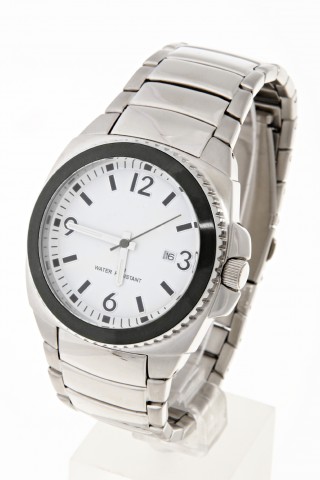
Afrikaners use this clock the most. The terms commonly used are voormiddag or the abbreviation v.m. (to indicate “ante meridiem/a.m.”), and namiddag or its abbreviation n.m. (to indicate “post meridiem/p.m.”).
These are most employed in writing, such as in: elf v.m. (“eleven a.m.)” or 09h00 n.m. (“09h00 p.m.”).
In conversations, though, you’ll most likely use other adjectives that indicate p.m. or a.m. in Afrikaans. Read on for more about this.
Twenty-Four-Hour Clock
The twenty-four-hour clock is also called military or astronomical time. This time format is based on the entire twenty-four-hour period, with each hour of the day having its own number.
When keeping time this way, the day starts at midnight and is indicated like this: 00:00. The last minute of the day is written as 23:59, or one minute before the next midnight. This system is clever and efficient. Therefore, it’s used by armed forces, pilots and airlines, astronomists, governments, hospitals, emergency services, and so forth.

In South Africa, this way of indicating the time isn’t commonly used colloquially, but more in writing.
How to write time in Afrikaans depends on the type of document you’re writing it down for. If you’re indicating the time in a non-fiction document, such as in a formal report, statement, or legal document, you can use either 12h00 or 12:00. Depending on which clock you use, you’ll either omit or add p.m. or a.m. in Afrikaans.
If you’re noting the time in a work of fiction, such as part of a dialogue, you’ll write it out in full, such as in “six o’clock” (sesuur).
Let’s get cracking on how to ask what time it is in Afrikaans, and how to tell it!
 Table of Contents
Table of Contents
- How to Ask for the Time in Afrikaans
- Hours / Ure
- Minutes / Minute
- Periods of Time in Afrikaans
- General Time References
- Adverbs of Time in Afrikaans
- BONUS! Time Proverbs, Sayings, and Odd Terms in Afrikaans
- AfrikaansPod101 Can Help You Tell the Time in Afrikaans in No Time!
1. How to Ask for the Time in Afrikaans

1- Formal
The following are polite and socially refined ways of asking the time in excellent Afrikaans. Use it if you want to impress someone!
Afrikaans: Kan u my sê wat die tyd is, asseblief?
Translation: “Could you tell me the time, please?”
Note: The u (“you”) in Afrikaans is the formal type of address, mostly used when talking to complete strangers, dignitaries, or older people you don’t know well. You can also use this sentence with the informal “you,” which is jy.
Afrikaans: Mag ek verneem wat die tyd is, asseblief?
Translation: “May I ask the time, please?”
2- Informal
Afrikaans: Hoe laat is dit nou, ‘seblief?
Translation: “What’s the time now, please?”
Note: “How late is it now, please?” is the literal translation of this Afrikaans sentence, but in English, you’d ask the question in a specific context. You’d use it, for instance, if you wanted to know how late at night it is, to which an answer could be: “very late” or “still early.”
In Afrikaans, though, this question is a common way of asking the time. Also note the contraction of asseblief (“please”). If you don’t know the person very well, or if you’re addressing a parent or older family member, it’s polite to use ‘seblief. If it’s your mate and you’re comfortable with one another, it’s okay to omit this word when asking for the time.
Afrikaans: Wat’s die tyd?
Translation: “What’s the time?”
Note: The same applies for ‘seblief as above. Also note the contraction for wat is to wat’s. (Like “what is” becomes “what’s.”)
Afrikaans: Hoe lank gaan dit neem om daar te kom?
Translation: “How long will it take to get there?”

Afrikaans: Hoe laat/Watter tyd moet ons by die lughawe wees?
Translation: “How late/What time must we be at the airport?”
What would the reply look like to questions like these?
2. Hours / Ure
There’s no distinction between a formal and informal way of telling time in Afrikaans. Keep in mind that you can also use an approximation with adverbs or adjectives.
Afrikaans: Dis nou presies agtuur.
Translation: “It’s now exactly eight o’clock.”
Afrikaans: Dit neem ongeveer ‘n uur om daar te kom.
Translation: “It takes approximately an hour to get there.”
Afrikaans: Ons vlieg nege-uur vanaand. So ons moet om-en-by sewe by die lughawe wees.
Translation: “We’re flying at nine o’clock tonight. So we must be at the airport around seven.”
Note: Just like with “o’clock,” the uur is sometimes omitted in casual conversations.
3. Minutes / Minute
Like in most casual and conversational English, noting the precise number of minutes isn’t very common in Afrikaans. Simply add the appropriate number to minuut (singular) or minute (plural).
Afrikaans: Hy hardloop vir ‘n minuut.
Translation: “He runs for a minute.”
Afrikaans: Ek gaan vir so twintig minute stort.
Translation: “I’m going to shower for approximately twenty minutes.”
Afrikaans: Die winkel is nog oop vir ‘n uur en vyftien minute.
Translation: “The shop is still open for an hour and fifteen minutes.”

Afrikaans: Sy praat nou al vir ses-en-dertig minute!
Translation: “She’s been talking for thirty-six minutes already!”
4. Periods of Time in Afrikaans

This has got nothing to do with Downton Abbey or Outlander. It refers to the divisions of an hour into quarters and halves.
This is how we say it in Afrikaans:
Afrikaans: kwart oor drie and kwart voor vyf
Translation: “quarter past three” and “quarter to five”
Note: Here, “quarter” and kwart are contractions of “quarter of an hour” and kwartier. It is, of course, a fifteen-minute increment.
Afrikaans: half vier
Translation: “half past three”
Note: Nope, it’s not wrong, and it can seem confusing. But it’s very easily explained. In English, talking about half of an hour (“half past three”) literally means: “It’s now a half-an-hour past/after three o’clock.” In Afrikaans, instead, talking about half of an hour (half vier) means: “It is now a half-an-hour to/before four o’clock.” Same thing, different angles, so to speak! It takes a bit of practice if you’re not used to it, but once you understand the concept, it’s very easy.
Afrikaans: Ons vertrek oor ‘n halfuur van die huis af.
Translation: “We’re leaving home in half an hour.”

Afrikaans: Die taxi gaan oor ‘n driekwartier hier wees.
Translation: “The taxi will be here in three quarters of an hour/forty-five minutes.”
5. General Time References
The following time words in Afrikaans are common references pertaining to time.
Afrikaans: oggend and aand
Translation: “morning” and “evening”
Example: Die oggend is koel, net soos die aand.
Translation: “The morning is cool, just like the evening.”
Afrikaans: nag and middernag
Translation: “night” and “midnight”
Example: Die nag is stil en middernag is donker.
Translation: “The night is quiet and midnight is dark.”
Afrikaans: vroegoggend and laataand
Translation: “early morning” and “late in the evening”
Example: Ons vertrek vroegoggend en keer laataand terug.
Translation: “We leave early in the morning and will return late in the evening.”
Afrikaans: laatnag
Translation: “late at night”
Example: Hy verkies dit om laatnag te ry.
Translation: “He prefers driving late at night.”
Afrikaans: sonsopkoms
Translation: “sunrise”
Example: Die sonsopkoms is asemrowend mooi.
Translation: “The sunrise is breathtakingly beautiful.”

Afrikaans: sonsondergang
Translation: “sunset”
Example: Die sonsondergang is net so mooi.
Translation: “The sunset is equally beautiful.”
Afrikaans: vanmiddag
Translation: “afternoon”
Example: Wat gaan ons vanmiddag eet?
Translation: “What are we eating this afternoon?”
Afrikaans: middag
Translation: “midday”
Example: Teen die middag was hy gesond.
Translation: “By midday, he was well.”
6. Adverbs of Time in Afrikaans
Afrikaans: onmiddelik
Translation: “right now” or “immediately”
Example: Hy wil sy kos onmiddelik hê.
Translation: “He wants his food right now.”

Afrikaans: oombliklik
Translation: “instantly”
Example: Die kos is oombliklik reg.
Translation: “The food is instantly ready.”
Afrikaans: ‘n oomblik
Translation: “momentarily”
Example: Sy bly ‘n oomblik stil.
Translation: “She pauses momentarily.”
Afrikaans: tans
Translation: “currently”
Example: Dis tans winter by ons.
Translation: “It’s currently winter here.”
Afrikaans: intussen
Translation: “meanwhile”
Example: Intussen, neem die pynstillers tot die dokter beskikbaar is.
Translation: “Meanwhile, take the painkillers until the doctor is available.”
Afrikaans: voor en na
Translation: “before” and “after” OR “afterward”
Example: Moenie die pille neem voor jy geëet het nie. Neem dit na die tyd.
Translation: “Don’t take the pills before you’ve eaten. Take them afterward.”

Afrikaans: terselfdertyd OR die selfde tyd
Translation: “simultaneously”
Example: Moenie pille en drank terselfdertyd neem nie.
Translation: “Don’t take pills and alcohol simultaneously.”
Afrikaans: binnekort and amper
Translation: “soon” and “almost”
Example: Ons gaan binnekort ry. Ek is amper reg.
Translation: “We’re leaving soon. I’m almost ready.”
Afrikaans: nou-nou
Translation: “in a while”
Example: Die taxi is nou-nou hier.
Translation: “The taxi will be here in a while.”
Afrikaans: vir ‘n lang tyd
Translation: “for a long time”
Example: Gaan julle ‘n lang tyd weg?
Translation: “Are you going away for a long time?”
Afrikaans: lankal
Translation: “for a long time already/now”
Example: Ons is al lankal hier.
Translation: “We’ve been here for a long time already.”
Afrikaans: enige tyd
Translation: “anytime”
Example: Bel my enige tyd.
Translation: “Call me anytime.”
Afrikaans: so gou as moontlik
Translation: “as soon as possible”
Example: Ek sal jou so gou as moontlik kontak.
Translation: “I will call you as soon as possible.”

7. BONUS! Time Proverbs, Sayings, and Odd Terms in Afrikaans
Afrikaans is a colorful, literal language, and some of its sayings about time are very quaint. Here are the most common and interesting Afrikaans time sayings!
Afrikaans: Moenie wors in ‘n hondehok soek nie.
Translation: “Don’t look for sausage in a kennel.”
Meaning: Don’t waste time on a lost cause!
Afrikaans: draaikous
Translation: Literally, this translates as “turn sock.” Nope, we don’t know either! But it means the same thing as “dawdler.”
Example: Die seun is ‘n regte draaikous!
Meaning: “That boy is a real dawdler!”
Afrikaans: hanna-hanna
Translation: There’s not a literal translation for this term.
Meaning: It’s an old Cape-Afrikaans saying that gets used when someone takes their time doing something.
Example: Jy hanna-hanna nou lekker met jou huiswerk, nê?
Translation: Approximation – “You’re dawdling with your homework, hey?”
Afrikaans: Die oggendstond het goud in die mond.
Translation: “Early dawn has gold in the mouth.”
Meaning: This means that those who rise early get more done.
Afrikaans: hoeka
Translation: Another one without a translation! An approximation would be “for a while now,” which means almost the same as lankal (discussed under the previous heading).
Example: Hy wag hoeka vir daardie verslag.
Translation: “He’s been waiting a while already for the report.”
Afrikaans: gevrek
Translation: “dead”
Meaning: Literally, it means something is dead, but it’s often used to indicate that someone is very slow and takes their time. It’s not a very flattering or polite way to describe a person, though!
Example: Die diens hier is maar gevrek!
Translation: “The service here is very slow!”
Do you have a favorite proverb or saying about time in your language? Share with us in the comments!

8. AfrikaansPod101 Can Help You Tell the Time in Afrikaans in No Time!

Don’t be a draaikous and waste precious time—enrol now with AfrikaansPod101! As a beginner, you’ll get access to helpful audio lessons, such as Choosing a Delivery Time in South Africa. Intermediate learners get access to dialogue examples such as What Time is it in South Africa? All of our lessons are designed to teach you how to sound like a native speaker from the word “go!”
That’s not all—you’ll have plenty of FREE learning tools at your disposal, such as many culturally-relevant vocabulary lists, a fantastic online Afrikaans Dictionary, and thousands of lessons in different formats!
Easily learn and practice Afrikaans grammar, vocabulary, reading & writing, comprehension, and much more with AfrikaansPod101!

All About Directions in Afrikaans – Your Best Guide!

Getting lost is never fun, even less so in a foreign country. Knowing how to give or ask for directions in Afrikaans is therefore a very helpful skill to have when visiting South Africa! Fortunately, most South Africans speak English, Afrikaans, and/or Zulu, three of the country’s eleven national languages. They’re normally a helpful, friendly people. So, if you know all about asking for directions in Afrikaans, you won’t easily get lost!
Learn the basics about how to give directions in Afrikaans (and ask for them), and more, at AfrikaansPod101. It’s our goal to keep your learning fun and easy!
Let’s start with the basic vocabulary you need to master. Whether you’re asking or giving directions in Afrikaans, knowing certain words and how native speakers pronounce them will make your life much easier on South African roads. For instance, “left” in Afrikaans is links, while “right” in Afrikaans is regs. There—you already know two of the most important direction words in the language!
Here’s an example of directions in Afrikaans to show you how you would use them in a sentence:
Basic sentence: Hou regs verby die Uniegeboue.
Translation: “Keep right (as you pass) the Union Buildings.”
Complex: Hou regs verby die Uniegeboue, en kyk uit links vir die hospitaal.
Translation: “Keep right as you pass the Union Buildings, and look out for the hospital on the left.”
“Straight” in Afrikaans is reguit, which is where we’re heading now—to vocabulary and phrases!
 Table of Contents
Table of Contents- Directions in Afrikaans: On the Road
- Directions in Afrikaans: On a Map
- Directions in Afrikaans: Survival Questions and Phrases
- Directions in Afrikaans: Landmarks
- Learn the Best Directions in Afrikaans at AfrikaansPod101!
1. Directions in Afrikaans: On the Road

Fortunately, Afrikaans and English are both Germanic languages. This means that they use the same alphabet; most Afrikaans can be translated literally into English and vice-versa.
ry reguit af — “drive/ride straight down”
Simple Sentence: Ry reguit af met Long Street.
Translation: “Drive straight down Long Street.”
Complex Sentence: Draai links en ry dan reguit af met Long Street.
Translation: “Turn left and then drive straight down Long Street.”
Note: The two languages share an expression that has to do with direction: “As the crow flies” / Soos die kraai vlieg. This means that something moves in a straight line from point A to point B. The expression allegedly originated in Scotland, with reference to a turnpike, or the so-called “crow road,” which denoted a direct route without detours.
The reference to a crow’s flight is somewhat mysterious, though. The bird can certainly be observed flying in a very straight and steady line at times. Yet this behavior isn’t particular only to crows or ravens, and they do circle a lot too. Some say it may refer to an ancient sailing practice, when ravens were released to point the sailors to land, but this can’t be historically confirmed.
gaan af met — “go down with”
Simple Sentence: Gaan af met daardie straat.
Translation: “Go down that street.”
Complex Sentence: Gaan af met daardie straat om die V & A Waterfront se ingang op links te kry.
Translation: “Go down that street for the entrance to the V & A Waterfront on your left.”
draai links / regs — “turn left / right”
Simple Sentence: Draai regs by die verkeerslig.
Translation: “Turn right at the traffic light.”
Complex Sentence: Draai regs by die verkeerslig en dan onmiddelik links by die ingang van die Voortrekker Monument.
Translation: “Turn right at the traffic light and then immediately left at the entrance of the Voortrekker Monument.”
gaan oor — “go over”
Note: Here, “go over” isn’t used literally. In English, we say “cross.”
Simple Sentence: Gaan oor daardie brug.
Translation: “Cross that bridge.”
Complex Sentence: Gaan oor daardie brug om by die Nelson Mandela Museum te kom.
Translation: “Cross that bridge to get to the Nelson Mandela Museum.”

oppad na — “on the way to”
Simple Sentence: Clarens is oppad na die Golden Gate Highland National Park.
Translation: “Clarens is on the way to the Golden Gate Highland National Park.”
Complex Sentence: Clarens is oppad na die Golden Gate Highland National Park, so draai links af van die hoofweg soontoe.
Translation: “Clarence is on the way to the Golden Gate Highland National Park, so turn left off the highway to go there.”
oorkant — “opposite”
Simple Sentence: Dis oorkant die apteek.
Translation: “It’s opposite the pharmacy.”
Complex Sentence: Dis oorkant die apteek wat jy moet regs draai en dan weer onmiddelik links.
Translation: “It’s opposite the pharmacy so you have to turn right and then immediately left again.”
langs — “next to”
Simple Sentence: Parkeer langs die motorhuis.
Translation: “Park next to the garage.”
Complex Sentence: Draai in by die tweede hek en parkeer langs die motorhuis.
Translation: “Turn in at the second gate and park next to the garage.”
voor and agter — “in front of” and “behind”
Simple Sentence: Ry voor in.
Translation: “Drive in at the front.”
Complex Sentence: Ry voor in en parkeer dan agter die huis.
Translation: “Drive in at the front and then park behind the house.”
ver and naby — “far” and “close”
Simple Sentence: Dis ver na Muizenberg strand toe.
Translation: “It’s far to Muizenberg Beach.”
Complex Sentence: Jy gaan ver ry om naby Muizenberg strand te kom.
Translation: “You’re going to drive far to get close to Muizenberg Beach.”

by die kruising — “at the crossing”
Simple Sentence: Gaan links by die kruising.
Translation: “Go left at the crossing.”
Complex Sentence: Gaan links by die kruising en hou reguit aan tot by die eerste verkeerslig.
Translation: “Go left at the crossing and keep straight until the first traffic light.”
om die draai — “around the corner”
Simple Sentence: Die kruidenier is net om die draai.
Translation: “The grocer is just around the corner.”
Complex Sentence: Die kruidenier is net om die draai van die publieke swembad.
Translation: “The grocer is just around the corner of the public swimming pool.”
Note: In both Afrikaans and English, this sentence can be an expression that means that something isn’t far from another thing. It could also serve as a literal direction in both languages.
binne stapafstand — “within walking distance”
Simple Sentence: Die winkel is binne stapafstand.
Translation: “The shop is within walking distance.”
Complex Sentence: Die winkel is binne stapafstand van die polisie stasie wat net oorkant die stadsaal is.
Translation: “The shop is within walking distance of the police station which is just opposite the city hall.”
gaan terug — “go back”
Simple Sentence: Gaan terug na Gautrein stasie.
Translation: “Go back to Gautrain Station.”
Complex Sentence: Gaan terug na Gautrein stasie se hoofingang en neem ‘n taxi na die middestad.
Translation: “Go back to Gautrain Station’s main entrance and take a taxi to the city center.”

X kilometer ver van — “X kilometers away from”
Simple Sentence: Kaapstad is 1400 kilometer ver van Johannesburg.
Translation: “Cape Town is 1400 kilometers away from Johannesburg.”
Complex Sentence: Dis beter om te vlieg as jy haastig is want Kaapstad is 1400 kilometer ver van Johannesburg.
Translation: “It’s better to fly if you’re in a hurry because Cape Town is 1400 kilometres away from Johannesburg.”
2. Directions in Afrikaans: On a Map
Fortunately, all the directions stay the same on a map, no matter where in the world you find yourself. Giving directions in Afrikaans could be made much easier when you have one of these in front of you—geared with the correct Afrikaans vocabulary, of course!

noord and suid — “north” and “south”
Simple Sentence: Draai noord by die meer.
Translation: “Turn north at the lake.”
Complex Sentence: Hou reguit aan met die grondpad en draai dan noord by die meer.
Translation: “Keep straight on with the gravel road and turn north at the lake.”
oos and wes — “east” and “west”
Simple Sentence: Oos, wes, tuis bes.
Translation: “East, west, home best.”
Note: This is an Afrikaans expression that means what it says: no matter how far and wide you travel, home remains the best place to return to.
Complex Sentence: By die stopstraat, kyk wes om die Tafelberg kabelkar te sien.
Translation: “At the stop street, look west to see the Table Mountain cable car.”
noordwes and noordoos — “northwest” and “northeast”
Simple Sentence: Mafikeng is in Noordwes provinsie
Translation: “Mafikeng is in North West Province.”
Complex Sentence: Zimbabwe is noordwes van Johannesburg, maar noordoos van Maputo.
Translation: “Zimbabwe is northwest of Johannesburg but northeast of Maputo.”
suidwes and suidoos — “southwest” and “southeast”
Simple Sentence: Namibië word ook Suidwes Afrika genoem.
Translation: “Namibia is also called Southwest Africa.”
Complex Sentence: Die Uil Huis is in Nieu Bethesda, wat suidoos lê van De Aar.
Translation: “The Owl House is in Nieu Bethesda, which lies southeast of De Aar.”
suidwesterlike and suidoosterlike — “southwestern” and “southeastern”
Simple Sentence: Die suidwesterlike deel van Suid Afrika is meestal woestynland.
Translation: “The southwestern part of South Africa is mostly desert land.”
Complex Sentence: Die Kaapse Dokter is ‘n sterk, droë suidoosterlike wind wat Kaapstad se besoedelde lug skoonmaak elke September.
Translation: “The Cape Doctor is a strong, dry southeastern wind that cleans Cape Town’s polluted air every September.”
noordwestelike and noordoostelike — “northwestern” and “northeastern”
Simple Sentence: Richardsbaai Wildreservaat lê in ‘n noordoostelike rigting vanaf Pietermaritzburg.
Translation: “Richard’s Bay Game Reserve lays in a northeastern direction from Pietermaritzburg.”
Complex Sentence: Gaborone, die hoofstad van Botswana, lê in ‘n noordwestelike rigting redelik naby aan Johannesburg.
Translation: “Gaborone, the capital city of Botswana, lays in a northwestern direction fairly close to Johannesburg.”

3. Directions in Afrikaans: Survival Questions and Phrases
Example: Waar is die stasie, asseblief?
Translation: “Where is the station, please?”
Example: Hoe kom ek by die hoofweg uit van hier af?
Translation: “How do I get to the highway from here?”
Example: Kan ek die trein soontoe neem?
Translation: “Can I take the train there?”
Example: Wat is die kortste roete na die lughawe?
Translation: “What is the shortest route to the airport?”
Note: Unfortunately, like most countries, South African cities have their dangerous spots. It could sometimes be prudent to ask for the safest route somewhere, as in: Wat is die veiligste roete na XXX? / “What is the safest route to XXX?” Or, before heading out on your own somewhere, you could ask: Is dit ‘n veilige area om te besoek? / “Is it a safe area to visit?”
Example: Ek het verdwaal. Kan u my help, asseblief? (Here the formal “you” is a polite, safe way to address strangers!)
Translation: “I am lost. Could you help me, please?”
Example: Hoe vêr is is dit te voet na die busstasie van hier af?
Translation: “How far is it by foot from here to the bus station?”

Example: Verskoon my, waar is die ruskamer, asseblief?
Translation: “Excuse me, where is the restroom, please?”
Example: Kan u my wys hoe om by die restaurant uit te kom, asseblief?
Translation: “Could you show me how to get to the restaurant, please?”
Example: Baie dankie vir u hulp! Ek waardeer dit baie.
Translation: “Thank you very much for your assistance! I really appreciate it.”
4. Directions in Afrikaans: Landmarks

When a map is either unavailable or useless, a landmark could make all the difference in finding your way in a strange city. Many landmarks have been used in the sentences above, but for your convenience, here’s a handy vocabulary list of the most common landmarks found anywhere.
| English | Afrikaans |
|---|---|
| “airport” | lughawe |
| “train station” | treinstasie |
| “bus station” | busstasie |
| “bus stop” | busstop |
| “taxi rank” | taxistaanplek |
| “rental car depot” | huurmotor depot |
| “harbor” | hawe |
| “city center” | middestad |
| “suburb” | buurt |
| “park” | park |
| “museum” | museum |
| “aquarium” | akwarium |
| “cinema” | rolprentteater |
| “vending machine” | vending machine |
| “theme park” | pretpark |
| “hospital” | hospitaal |
| “church” | kerk |
| “zoo” | dieretuin |
| “garden” | tuin |
| “fountain” | spuitfontein |
| “waterpark” | waterpark |
| “elevator” | hysbak |
| “escalator” | roltrap |
| “revolving doors” | swaaideure / draaideure |
| “bathroom” | badkamer |
| “parking lot” / “parkade” | parkeerplek / parkade |
| “gate” | hek |
| “statue” | standbeeld |
5. Learn the Best Directions in Afrikaans at AfrikaansPod101!

So, reader, how do you feel about giving or asking for directions in Afrikaans now? Is there anything you still want to know about directions in Afrikaans? Let us know in the comments; we’ll be glad to help!
Learning with us, you’ll be thoroughly trained to ask for and give directions in Afrikaans. We teach Afrikaans directions with vocab lessons that use listening comprehension, hundreds of vocab lists, many Afrikaans reading exercises, lessons with slideshows and recorded audio (such as this The Top 10 Ways to Prepare for Travel lesson), and so much more! Arm yourself with an online Afrikaans dictionary, thousands of Afrikaans key phrases, and a Word of the Day to stay at the top of your game.
Never get lost anywhere in South Africa with AfrikaansPod101. Sign up today!

Learn the 100 Most Common Nouns in Afrikaans

A noun in Afrikaans is called a selfstandige naamwoord, which literally translates as “independent name word.” That makes sense, considering that nouns are the names of people, places, animals, things, and ideas or concepts. Yet, when looking at any sentence, what is a noun in Afrikaans?
The answer to that isn’t overly simple, like in any other language, but that’s the nature of grammar for you. That said, it’s not impossibly difficult, so why not learn the difference between a common noun in Afrikaans and a collective noun in Afrikaans at AfrikaansPod101? We make it easy for you!
Take a look at this list of the Fifty Most Common Nouns in Afrikaans, for instance. It’s possible to speak like a native Afrikaner with our help!
For this article, we won’t venture into the classification of nouns in Afrikaans grammar, but rather supply you with an excellent list of the most useful ones.
Tip: Here’s a trick to identify common nouns easily in any sentence. If you can meaningfully use the word together with an article (a, the / ‘n, die), it’s a noun!

Table of Contents
- Nouns in Afrikaans: Home Appliances (huis toestelle)
- Nouns in Afrikaans: Technology (tegnologie)
- Nouns in Afrikaans: Transport (vervoer)
- Nouns in Afrikaans: Services (dienste)
- Nouns in Afrikaans: Careers and Jobs (loopbane and werk)
- Nouns in Afrikaans: Animals
- AfrikaansPod101 Teaches You the Best Nouns – Easily and Fast!
1. Nouns in Afrikaans: Home Appliances (huis toestelle)

Noun: yskas and vrieskas
Translation: “fridge” and “freezer”
Use: Die yskas is splinternuut, maar die vrieskas is nie.
Translation: “The fridge is brand new, but the freezer is not.”
Noun: stoof and oond
Translation: “stove” and “oven”
Use: Gebruik jy die stoof of die oond?
Translation: “Do you use the stove or the oven?”
Noun: ketel
Translation: “kettle”
Use: Skakel die ketel af, asseblief.
Translation: “Please switch off the kettle.”
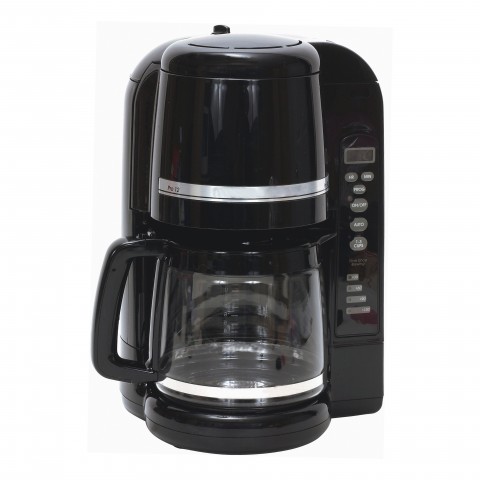
Noun: koffiemasjien
Translation: “coffee maker” / “coffee machine”
Use: Ek verkies koffie wat met die koffiemasjien gemaak is.
Translation: “I prefer coffee made with the coffee machine.”
Noun: broodrooster
Translation: “bread toaster”
Use: Die broodrooster is ‘n handige toestel.
Translation: “The bread toaster is a handy appliance.”
Noun: elektriese kosmenger
Translation: “electric food mixer”
Use: ‘n Elektriese kosmenger maak kosmaak maklik.
Translation: “An electric food mixer makes food preparation easy.”
Noun: blikoopmaker
Translation: “can opener”
Use: Gebruik die blikoopmaker op daardie blikkie tuna.
Translation: “Use the can opener on that tin of tuna.”
Noun: skottelgoedwasser
Translation: “dishwasher”
Use: Ek is baie dankbaar om ‘n skottelgoedwasser te hê.
Translation: “I’m very grateful to have a dishwasher.”
Noun: mikrogolf oond
Translation: “microwave oven”
Use: Daardie mikrogolf oond is skoon.
Translation: “That microwave oven is clean.”
Noun: haardroër
Translation: “hair dryer”
Use: Sy gebruik ‘n goeie haardroër.
Translation: “She uses a good hair dryer.”
Noun: lugverkoeler or lugversorger
Translation: “air conditioner”
Use: Die huis het ‘n nuwe lugverkoeler nodig.
Translation: “The house needs a new air conditioner.”
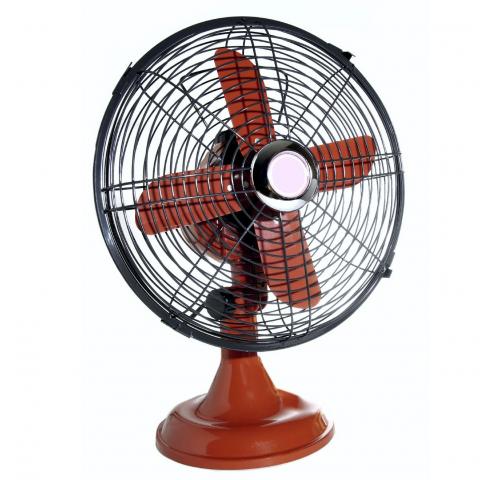
Noun: waaier
Translation: “fan”
Use: Dis warm, sit die waaier aan, asseblief.
Translation: “It’s hot, switch on the fan, please.”
Note: Dis is a contraction of dit is—exactly the same as “it’s” is a contraction of “it is.”
Noun: verwarmer
Translation: “heater”
Use: Ons gebruik die verwarmer net in die winter.
Translation: “We use the heater only during the winter.”
Noun: wasmasjien
Translation: “washing machine”
Use: Gebruik jy ooit jou wasmasjien?
Translation: “Do you ever use your washing machine?”
Noun: tuimeldroër
Translation: “tumble dryer”
Use: Die klere in die tuimeldroër is droog.
Translation: “The clothes in the tumble dryer are dry.”
2. Nouns in Afrikaans: Technology (tegnologie)
Noun: televisie
Translation: “television”
Use: Ons het ‘n groot televisie.
Translation: “We have a large television.”
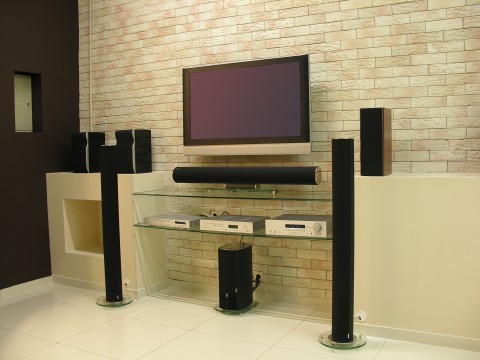
Noun: DVD speler
Translation: “DVD player”
Use: Hy skakel die DVD speler aan.
Translation: “He switches on the DVD player.”
Noun: afstandbeheerder
Translation: “remote controller”
Use: Waar is die afstandbeheerder?
Translation: “Where is the remote controller?”
Noun: rekenaar
Translation: “computer”
Use: Hierdie is ‘n ou rekenaar.
Translation: “This is an old computer.”
Noun: skootrekenaar
Translation: “laptop”
Use: Ek verkies skootrekenaars.
Translation: “I prefer laptops.”
Noun: slimfoon
Translation: “smartphone”
Use: iPhone is my gunsteling slimfoon.
Translation: “The iPhone is my favorite smartphone.”
Noun: faksmasjien
Translation: “fax machine”
Use: Weet jy hoe die faksmasjien werk?
Translation: “Do you know how the fax machine works?”
Noun: fotokopiëerder/fotokopiëerapparaat
Translation: “photocopier”
Use: Daar is nie papier in die fotokopiëerder nie.
Translation: “There’s no paper in the photocopier.”

Noun: telefoon
Translation: “telephone”
Use: Die telefoon lui.
Translation: “The telephone rings.”
Noun: selfoon
Translation: “cell phone”
Use: Dit is ‘n duur selfoon daardie.
Translation: “That is an expensive cell phone.”
Noun: batterylaaier
Translation: “battery charger”
Use: Die batterylaaier is op die rak.
Translation: “The battery charger is on the shelf.”
Noun: oorfone
Translation: “headphone” / “earphones”
Use: Daardie is goeie oorfone.
Translation: “Those are good earphones.”
Noun: webwerf
Translation: “website”
Use: Hy het sy eie webwerf.
Translation: “He has his own website.”
Noun: wifi; internet; account; file; image/pi; app
Note: For use in reference to web-technology, these words don’t have Afrikaans translations. Sometimes foto (photo) is used for “image/pic.” However, almost every Afrikaans-speaking person will understand you if you use these English terms in context!
Noun: wagwoord
Translation: “password”
Use: Wat is jou wagwoord vir hierdie app?
Translation: “What is your password for this app?”
Noun: wifi konneksie
Translation: “wifi connection”
Use: Dis ‘n uitstekende wifi konneksie hierdie.
Translation: “It’s an excellent wifi connection.”
Note: Again, dis is a contraction of dit is. Exactly the same as “it’s” is a contraction of “it is.”
3. Nouns in Afrikaans: Transport (vervoer)

Noun: motorkar
Translation: “motor car”
Use: Sy ry ‘n rooi motorkar.
Translation: “She drives a red motor car.”
Note: As in English, motorkar is most often abbreviated to just motor or kar.
Noun: voertuig and trok
Translation: “vehicle” and “truck”
Use: ‘n Trok is ‘n groot voertuig.
Translation: “A truck is a large vehicle.”
Noun: trein
Translation: “train”
Use: Die Blou Trein is die mees luukse treindiens in Suid Afrika.
Translation: “The Blue Train is the most luxurious train service in South Africa.”
Noun: treinspoor and stasie
Translation: “railroad” and “station”
Use: Daardie treinspoor lei nie na die stasie nie.
Translation: “That railroad doesn’t lead to the station.”

Noun: vliegtuig
Translation: “airplane”
Use: Ons vliegtuig styg binnekort op.
Translation: “Our airplane takes off soon.”
Noun: lughawe
Translation: “airport”
Use: OR Tambo is Suid Afrika se grootste lughawe.
Translation: “OR Tambo is South Africa’s largest airport.”
Noun: boot
Translation: “boat”
Use: Die boot seil vinnig.
Translation: “The boat sails fast.”
Noun: hawe
Translation: “harbor”
Use: Dis winderig by die hawe.
Translation: “It’s windy at the harbor.”
Note: Can you spot the contraction…?!
Noun: motorfiets
Translation: “motorbike”
Use: My pa het ‘n groot motorfiets.
Translation: “My dad has a large motorbike.”
Noun: huurmotor and taxi
Translation: “rental car” and “taxi”
Use: Moet ons ‘n huurmotor of ‘n taxi kry?
Translation: “Shall we get a rental car or a taxi?”
Noun: taxistaanplek
Translation: “taxi rank”
Use: Die taxistaanplek is nie veilig laat in die nag nie.
Translation: “It’s not safe at the taxi rank late at night.”

Noun: bus and busstop
Translation: “bus” and “bus stop”
Use: Neem die groot, rooi bus by die busstop.
Translation: “Take the large, red bus at the bus stop.”
Noun: fiets
Translation: “bike”
Use: Om met die fiets te ry hou jou fiks.
Translation: “Riding a bike keeps you fit.”
Noun: verkeerslig or robot
Translation: “traffic light”
Use: Die verkeerslig/robot is groen; jy kan gaan.
Translation: “The traffic light is green; you can go.”
Note: Even English-speaking South Africans refer to a traffic light as a “robot!” This term was apparently carried over from a time when policemen regulated traffic. Their stilted, unnatural movements earned them the nickname of “robot policemen,” eventually shortened to just “robot.”
Noun: pad and hoofweg
Translation: “road” and “highway”
Use: Hierdie is die pad na die hoofweg.
Translation: “This is the road to the highway.”
Noun: kruising
Translation: “intersection”
Use: Draai regs by die eerste kruising.
Translation: “Turn right at the first intersection.”
Noun: brug and duikweg
Translation: “bridge” and “subway”
Use: Die duikweg onder daardie brug was oorspoel na die reën.
Translation: “The subway underneath that bridge was flooded after the rain.”

4. Nouns in Afrikaans: Services (dienste)
Afrikaans nouns distinguish between the masculine and the feminine for words pertaining to people and animals, with some exceptions. Keep this in mind as you read through this Afrikaans nouns list.
Noun: dokter and hospitaal
Translation: “doctor” and “hospital”
Use: Ek moet ‘n dokter by die hospitaal gaan sien.
Translation: “I need to see a doctor at the hospital.”
Note: Dokter is used for both male and female physicians.

Noun: noodvoertuig and ambulans
Translation: “emergency vehicle” and “ambulance”
Use: Daar was ‘n ambulans en ‘n ander noodvoertuig.
Translation: “There was an ambulance and another emergency vehicle.”
Noun: tandarts and tandpyn
Translation: “dentist” and “toothache”
Use: Hy het tandpyn en moet ‘n tandaarts gaan sien.
Translation: “He has a toothache and must see a dentist.”
Note: Tandarts is used for both male and female dentists.
Noun: brandweer and vuur
Translation: “fire department” and “fire”
Use: Bel die brandweer oor die vuur in die berge.
Translation: “Call the fire department about the fire in the mountains.”
Note: Male firefighter: brandweerman. Female firefighter: brandweervrou.

Noun: apteekster and apteek
Translation: “pharmacist” and “pharmacy”
Use: My tannie is ‘n apteekster. Haar apteek is in die hoofstraat.
Translation: “My aunt is a pharmacist. Her pharmacy is in the main street.”
Note: Male pharmacist: apteker. Female pharmacist: apteekster.
Noun: polisie and polisiestasie
Translation: “police” and “police station”
Use: Die polisie werk by die polisie stasie.
Translation: “The police works at the police station.”
Note: Policeman: polisieman. Police woman: polisievrou.
5. Nouns in Afrikaans: Careers and Jobs (loopbane and werk)

Noun: prokureur
Translation: “lawyer”
Use: Sy wil ‘n prokureur word.
Translation: “She wants to become a lawyer.”
Note: There’s no gender differentiation between male and female lawyers in Afrikaans.
Noun: elektrisiën
Translation: “electrician”
Use: Bel die elektrisiën, ons krag is af.
Translation: “Call the electrician, our electricity is down.”
Note: Elektrisiën is used for both male and female electricians.
Noun: loodgieter
Translation: “plumber”
Use: Die loodgieter het die lek reggemaak.
Translation: “The plumber fixed the leak.”
Note: As in English, there’s no distinction between a male and a female plumber in Afrikaans.
Noun: onderwyser (male) and onderwyseres (female) and skool
Translation: “teacher” and “school”
Use: Daardie onderwyser en onderwyseres by my skool is getroud.
Translation: “Those two teachers at my school are married.”
Note: Onderwyser is a male teacher in Afrikaans, and onderwyseres is a female teacher.

Noun: vlieënier
Translation: “pilot”
Use: My man is ‘n vlieënier in die lugmag.
Translation: “My husband is a pilot in the air force.”
Note: Vlieënier is used for both genders in Afrikaans.
Noun: akteur and aktrise
Translation: “actor” and “actress”
Use: Die mooi aktrise is getroud met die goed-geboude akteur.
Translation: “The pretty actress is married to the well-built actor.”
Note: Aktrise is “actress” and akteur is “actor.”

Noun: sanger and sangeres
Translation: “singer” and “songstress”
Use: Die sanger het ‘n diep stem, en die sangeres het ‘n hoë een.
Translation: “The singer has a deep voice, and the songstress has a high one.”
Note: Sangeres is “songstress” and sanger is “singer.”
Noun: kunstenaar and kunstenares
Translation: “artist”
Use: Die kunstenaar se baard is lank, terwyl die kunstenares se hare lank is.
Translation: “The (male) artist’s beard is long, while the (female) artist’s hair is long.”
Note: Kunstenaar is the male artist, and kunstenares is the female artist.
6. Nouns in Afrikaans: Animals
Noun: mannetjie and wyfie and klein katjies
Translation: “male” and “female” animals and “kittens”
Use: Dis ‘n mooi wyfie en groot mannetjie kat. Hulle gaan lieflike klein katjies hê.
Translation: “It’s a pretty molly and a large tom cat. They will have lovely kittens.”
Note: These terms, mannetjie and wyfie, are used to describe gender in many animal species where no specific names exist in Afrikaans.
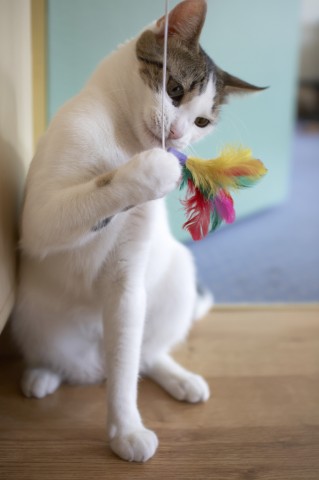
Noun: hen and haan and kuikens
Translation: “hen” and “rooster” and “chicks”
Use: Die haan kraai terwyl die hen en kuikens rondloop.
Translation: “The rooster crows while the hen and chicks roam about.”
Note: In Afrikaans, hen is “hen” and haan is “rooster.”
Noun: teef/tefie and reun
Translation: “female dog” and “male dog”
Use: Hierdie tefie en reun het klein hondjies.
Translation: “This female dog and male dog have puppies.”
Note: In Afrikaans, teef or tefie is a female “dog” and reun is a male “dog.”
Noun: hings and merrie and stal
Translation: “stallion” and “mare” and “stable”
Use: Die hings en merrie slaap in die stal.
Translation: “The stallion and mare sleep in the stable.”
Note: In Afrikaans, hings is “stallion” and merrie is “mare.”
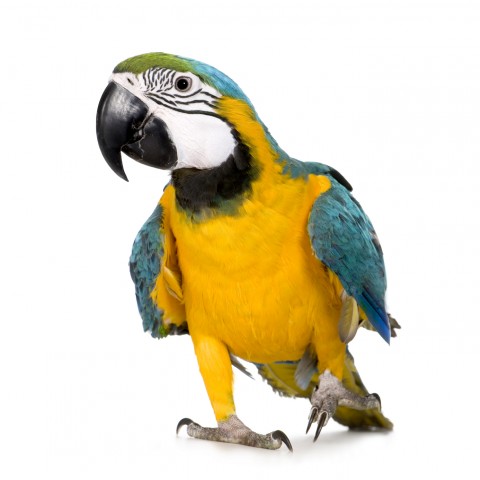
Noun: papegaai
Translation: “parrot”
Use: My papegaai kan praat..
Translation: “My parrot can talk.”
Note: There is no gender-specific names for papegaai in Afrikaans. To differentiate, you could refer to a mannetjie papegaai (male parrot) and a wyfie papegaai (female parrot), like with cats.
Noun: volstruis
Translation: “ostrich”
Use: Moenie dat ‘n volstruis jou jaag nie.
Translation: “Don’t let an ostrich chase you.”
Note: There’s no gender differentiation for volstruise.
What’s your favorite pet or animal? Share with us in the comments!
7. AfrikaansPod101 Teaches You the Best Nouns – Easily and Fast!

Our goal is to help you learn a new language as easily and with as much fun as possible! Our focus is also on usefulness. For instance, learn your culturally-relevant and topic-related Afrikaans nouns through hundreds of lessons, such as the Top 20 Words You’ll Need for the Internet and Back to School Essentials. Or, prepare yourself for a night out with this relevant restaurant vocabulary lesson. Then blow your Afrikaans friends’ minds with your mastery of the 100 Core Afrikaans Words!
AfrikaansPod101 is one of the most forward online language-learning platforms, where you can explore this quaint and descriptive language in various formats. These include sound and video recordings, downloadable PDF lessons, apps, and more, all geared for your easy access. Other helpful tools include a comprehensive online Afrikaans dictionary, essential Afrikaans Key Phrases, and numerous Vocabulary Lists. What’s not to love? Sign up today!

Top Compliments in Afrikaans for All Occasions!
Who doesn’t love receiving compliments?! If they’re sincere, they can make our whole being light up like a Christmas tree.
Giving compliments also has benefits, and Afrikaners know this! Praising people makes us feel connected to them, and this improves our own sense of well-being. After all, South Africans believe in and uphold the spirit of ubuntu. This popular philosophy implies that our own humanity is only fulfilled through the recognition and appreciation of another’s uniqueness and humanity.
So, spread ubuntu by learning to give Afrikaans compliments (komplimente) like a native speaker at AfrikaansPod101.com—we make it fast, easy, and fun!

Table of Contents
- Why is it Important to Know How to Give and Receive Compliments in Afrikaans?
- How Can AfrikaansPod101 Help You Learn Important Afrikaans Compliments?
1. Why is it Important to Know How to Give and Receive Compliments in Afrikaans?
Before we start, let’s first look a bit at the importance of giving sincere compliments.
Let’s look at what the research says.
According to studies, compliments and praise can have the following effects:
1) It can boost one’s efficiency at work.
2) It can make you feel more efficient.
3) You will act and work more autonomously if you get praised often.
4) Praise increases a sense of well-being in both the compliment giver and the receiver.
5) Compliments have been shown to be a good incentive for task engagement.
6) Praise and compliments increase motivation, which, in turn, accelerates motor skill performance.
7) We also know that by focusing on the positive in our lives, we feel better about ourselves, others, and the world.
These are seven excellent reasons to start dishing out Afrikaans compliments, isn’t it?
But…and this is an important “but”…
A) Compliments and Praise Must Be Sincere
Most South Africans, including Afrikaners, are gregarious, generous people with big hearts. They love to celebrate good stuff—it’s ingrained in their culture.
Look, for instance, at a movement that’s recently taken South Africa (and the world) by storm!
#ImStaying was started on Facebook as an initiative for South Africans to be consciously and deliberately positive about their country. South Africa is still, even after decades of being a true democracy, in recovery from its very painful past of gross human rights infringements. Even in the face of slow but sure improvement, many still feel negative, even hopeless, about their future and lives.
#ImStaying proved a fast-growing and fast-moving social media phenomenon, with many South Africans from literally everywhere connecting through positive and complimentary attitudes toward each other.
This is because giving compliments in Afrikaans, or in any of the other ten national languages, turns out to come quite naturally for South Africans. Many even report that the group changed their lives.
Yet Afrikaners expect the same transparency and strength of character if you want to win their friendship and trust, and most of all, their respect.
“What you see is what you get” is a fairly common cultural trait, and they expect the same from others.
Also, insincere flattery won’t get you far. In fact, this and other false behaviors are probably the easiest ways to lose an Afrikaner’s trust and respect. They’re not alone in this.
In an interview with Huffingtonpost Australia, Professor Nick Haslam (School of Psychological Sciences, University of Melbourne) explained that false compliments are likely to have the opposite effect as genuine ones.
According to Haslam, those on the receiving end of false flattery will often sense the insincerity and perceive the compliments as ill-intentioned. This will undermine any positive effects a person might feel about being praised, he said.
So, rather stay real!
Now that we got that out of the way, let’s engage in the feel-good stuff. These are the best Afrikaans compliments to memorize.
B) Complimenting Someone’s Appearance
Especially when we’ve taken extra care with our appearance, we want others to notice it and comment favorably. Here are some good compliments (and pick-up lines!) in Afrikaans.
1) Jy lyk goed vandag/vanaand. (“You’re looking good today/tonight.” )
This is an understated and gender-neutral compliment in Afrikaans that any Afrikaner will appreciate. As long as it’s delivered with respect and the appropriate personal distance, you can also use this one at work.
Afrikaner men aren’t used to being complimented on their appearance, but they’re not immune to its mojo! This phrase is probably the one you’d want to use.
Making it Stronger…
One way to make this compliment in Afrikaans stronger is by adding and emphasizing regtig (“really” ) or baie (baie translates literally as “a lot,” but in this case, it means “very” ), as in:
- Jy lyk regtig goed vandag. (“You look really good today.” )
- Jy lyk baie goed vandag. (“You look very good today.” )
If you’re truly blown away by the person’s appearance, you could even add both regtig and baie:
- Jy lyk regtig baie goed vandag. (“You look really very good today.” )
2) Jy lyk mooi! (“You look pretty!” )
This common Afrikaans compliment can serve well as platonic and romantic praise. The phrase is usually directed at women and/or girls. Female friends and colleagues are more open in their exchange, and they use this compliment often and spontaneously.
Making it Stronger…
To add strength to this compliment, you could again add regtig and baie, just like in the examples above.
- Jy lyk regtig baie mooi! (“You look really very pretty!” )
Or, you could just say: Jy lyk baie mooi! (“You look very pretty!” )
Other words you can replace mooi (“pretty” ) with include:
- pragtig (“beautiful” )
- verruklik (“enchanting” )
- asemrowend (“breathtaking” )
- beeldskoon (“gorgeous” )
Note: These adverbs are already the superlative form of mooi (“pretty” ). They’re generally eloquent enough for Afrikaners, so, unlike in English, you won’t use baie (“very” ) to enhance their impact. However, you could add regtig (“really” ), if you prefer.
- Jy lyk regtig pragtig. (“You look really beautiful.” )
3) Being Specific
When someone has taken extra care with a specific aspect of their appearance, it’s only good manners and social etiquette to compliment them on it. Also, it could make their day!
Speak up, for instance, when it’s clear that someone has visited the hairdresser or bought new clothes.
3.1 At Work
It’s necessary to be careful about how you compliment someone at work. Boundaries can be easily overstepped, unfortunately. So, don’t get too personal with your praise, unless you and a colleague are also social buddies.
Yet few things oil the wheels of pleasant working relations like compliments! So here’s how to go about giving compliments in Afrikaans while at work:
It’s best to treat men and women equally by phrasing the compliment in a somewhat muted, almost formal manner.
- Jou hare lyk goed. (“Your hair looks good.” )
- Is dit ‘n nuwe uitrusting? Dit pas jou goed. (“Is this a new outfit? It fits you well.” )
- Ek hou van jou jas. (“I like your coat.” )
- Jy het ‘n mooi hemp aan. (“You’re wearing a nice shirt.” )
- Daardie rok lyk goed aan jou. (“That dress looks good on you.” )
3.2 At Home or on a Date
In informal situations, with people you know well, you can be more effusive!
- Jou hare lyk fantasties! (“Your hair looks fantastic!” )
- Ek is mal oor jou rok. (“I’m crazy about your dress.” )
- Jy het die mooiste tande! (“You have the prettiest teeth!” )
- Jy is die mooiste vrou met wie ek nog ooit uitgegaan het. (“You are the prettiest woman I’ve ever dated.” )
- Jy ruik lekker. (“You smell good.” )
- Jy het sulke mooi oë. (“You have such beautiful eyes.” )
- Jou glimlag is pragtig. (“Your smile is beautiful.” )
- Wow, jy’t groot spiere! (“Wow, you have big muscles!” ) Note: Avoid telling this to a woman. Unless she’s a bodybuilder, of course.
C) Afrikaans Compliments for a Job Well Done
The majority of adults spend most of their lives working. Therefore, being complimented for what you’re doing feels really good!
Here are some of the top Afrikaans compliments to use when someone has excelled at their tasks. The compliment is often an expression of gratitude as well.
1) Dankie vir jou werk. (“Thank you for your work.” )
This is a thank-you that also serves as a gender-neutral, understated Afrikaans compliment. It can be delivered either in person, or in a written note.
Making it Stronger…
Adding baie before dankie will strengthen this phrase. In this case, it translates as “very much.” To the same effect, you could also add harde (which means “hard” ) in front of werk.
- Baie dankie vir jou harde werk. (“Thank you very much for your hard work.” )
Note: This stronger phrase is somewhat nuanced, as it sounds less obligatory, indicating that you really mean it. If you rarely give compliments at work, though, the first, less embellished phrase is perfectly fine.
2) Goeie werk. (“Good/nice job.” )
Depending on how effusive your delivery usually is, and how you compliment other staff, this terse compliment could come across as a veiled insult.
Or, it could simply be a muted but sincerely meant compliment. Gauge the situation wisely, and make it stronger by adding baie, as in:
- Baie goeie werk. (“Very good job.” )
Baie goeie can be replaced with the following superlatives:
- uitstekende (“excellent” )
- fantastiese (“fantastic” )
- indrukwekkende (“impressive” )
- uitstaande (“outstanding” )
3) Geluk, dis uitstekende werk. (“Congratulations, that’s excellent work.” )
This phrase adds a congratulation, and is quite strong and expressive. Best save this for work that’s exceptionally well-executed.
Again, emphasize your amazement with a brilliant piece of work by adding baie:
- Baie geluk, dis uitstekende werk.
There’s no common English equivalent for this expression, but it literally translates as: “Many congratulations, it’s excellent work.”
4) Jy’t fantasties goed gedoen. (“You’ve done fantastically well.” )
This is a less formal compliment on a job well done, probably better suited for a more informal work environment.
Also, that Afrikaans friend who attained her medical degree with honors? Or your Afrikaans neighbor’s daughter who performed her first piano concert to great acclaim? Use this phrase to acknowledge and compliment their accomplishments.
Making it Stronger…
If you feel almost overwhelmed with admiration, you could add regtig to this Afrikaans compliment:
- Jy het regtig fantasties goed gedoen. (“You have really done fantastically well.” )
Depending on your relationship with the receiver, you could add a phrase like: Ek is beïndruk. (“I am impressed.” )
Note: If you’re a parent, lecturer, or teacher complimenting someone on a brilliant assignment or excellent grades, adding this phrase would be a personal touch that can be very encouraging. This is also the case if you have a fairly personal, almost mentoring relationship with the person.
However, be sensitive about how you use it, because some could construe it as patronizing. It’s probably best not to compliment, for instance, your CEO on his work performance with this phrase.
5) Other Commonly Used Afrikaans Compliments for Good Work
- Wonderlike idee! (“Wonderful idea!” )
- Ek het gehou van jou presentasie. (“I liked your presentation.” )
- Goed waargeneem. (“Well observed.” )
D) Complimenting Someone’s Skills in Afrikaans
Sometimes someone exhibits exceptional skills. This is how you show your admiration and compliment them in Afrikaans.
1) In the Kitchen:
- Jy is ‘n wonderlike kok. (“You are a wonderful cook.” )
- Die gereg is uitstekend voorberei. (“The dish is excellently prepared.” )
- Dankie, dit was heerlik! (“Thank you, that was delicious!” ) Note: This can be used formally or informally.
- Dankie vir die lekker kos! (“Thank you for the tasty food!” ) Note: This is a more informal compliment.
- Ek het baie lekker geëet, baie dankie! (There’s no direct translation, but it means: “I’ve really enjoyed the meal, thank you very much!” )
- Jy maak die beste koffie onder die son. (“You make the best coffee under the sun.” ) Note: Replace koffie (“coffee” ) with any beverage or food for a heartwarming compliment.
2) In the Garden:
- Jy het groen vingers! (“You have green fingers!” ) Note: This compliment means exactly the same in English; the person is an exceptional gardener, or they can make any plant grow or flourish.
- Jy het die gras goed gesny. (“You mowed the lawn well.” )
- Die blomme is wonderlik gerangskik. (“These flowers are wonderfully arranged.” )
3) In the House:
- Jy het ‘n slag met binneshuise versiering! (“You have a knack for interior decorating!” )
- Jy’ het hierdie kamer so mooi reggemaak. (“You fixed this room so beautifully.” )
- Ek dink jy het baie goeie smaak. (“I think you have very good taste.” )
4) General:
- Jy praat Afrikaans asof dit jou voertaal is. (“You speak Afrikaans like it’s your mother tongue.” )
- Jy praat Afrikaans soos ‘n Afrikaner! (“You speak Afrikaans like an Afrikaner!” ) Note: The former is the more formal version of this compliment.
- Jy tokkel die klavier soos ‘n meester! (“You play the piano masterfully!” ) Note: Tokkel is a casual word that refers to piano playing. It may have been derived from “tickle the keys,” also a reference specific to piano playing. This is a genial, humorous compliment.
- Jy het vele talente. (“You have many talents.” )
- Dans jy professioneel? (“Do you dance professionally?” )
- Jy het ‘n goeie sin vir humor. (“You have a good sense of humor.” )
- Jy het ‘n slag met woorde. (“You have a way with words.” )
E) Behavior and Body Language
Afrikaners love receiving sincere compliments, as said. Only the most arrogant celebrities are immune to this!
When you deliver a compliment, a warm smile while looking the person in the eye will, in most cases, be the appropriate body language and behavior. Your open admiration or appreciation will probably elicit a shy smile, embarrassed laughter, and muffled self-deprecation from most South Africans. Simply assure them that you mean it, and enjoy feeling good because you made someone else feel great!
2. How Can AfrikaansPod101 Help You Learn Important Afrikaans Compliments?
Which is your favorite Afrikaans compliment? Tell us in the comments!
Learning how to give compliments in Afrikaans is easy and fun, just as we designed it to be! With over a decade of experience, we draw on expert knowledge of online language-learning techniques to offer you a unique learning space. Thousands of Afrikaans lessons are available at your fingertips, together with free resources such as apps for Android, iPhone, iPad, and Kindle Fire.
With AfrikaansPod101, you can also create your own collection of vocab lists, learn the Afrikaans alphabet, and so much more!
Many enrollment options are available to suit your personal needs. For instance, don’t be alone in your learning—sign up for your personal tutor with Premium PLUS. Our friendly hosts are available 24/7 online to help you master Afrikaans easily. With a bit of effort and perseverance, you could do so in record time.
Also enjoy features such as:
- Culturally relevant lessons
- A free online Afrikaans dictionary
- Access to Afrikaans Key Phrases
- Hundreds of lessons in different formats
Don’t hesitate—enroll now and learn the best Afrikaans compliments to make friends and influence people!

Getting Angry in Afrikaans – the Best Phrases and Vocab!
So, you know how to say “I’m sorry” in Afrikaans, and these are likely of the most important phrases to learn. Because no matter what language you speak, you’re probably going to get angry at some point, say things you don’t mean and then have to apologize for it.
Yet, knowing how to get angry in Afrikaans has benefits too! Read on for more about that, also how it’s all easily done through AfrikaansPod101!
There are some serious upsides to getting angry:
- When your boundaries are being ignored, and the offender refuses to heed a gentle, civil admonition, showing your anger might be the only way to get your point across with good effect.
- Anger can give you negotiating power, research has shown.
- Furthermore can anger be a good motivator. Looking at the world’s history, the driving forces behind revolutions were always anger and frustration. Constructive anger can motivate you to get what you truly desire.
- Strangely enough, one U.S. field study has shown that angry people were more optimistic about the future! Conducted after the 9/11 attacks, the study demonstrated that the angrier people were about terrorism, the fewer attacks they expected in future.
- Yet another study has indicated that getting angry with a partner and expressing it immediately may be better for the relationship in the long run. Obviously, it would be best to avoid getting terribly, explosively angry with one another! Also, working constructively towards a solution is what strengthens the bond. If you find that you’re getting angry easily and for no reason, it would be good to seek help.
However, no matter how angry you are, it is never OK to engage in physical assault, unless it is to protect yourself or a vulnerable person.

Table of Contents
- Why is it Necessary to Know Angry Phrases in Afrikaans?
- Phrases that Depict Anger in Afrikaans
- Constructive Ways to Express Anger in Afrikaans
- How AfrikaansPod101 Can Help You With Being Angry in Afrikaans!
1. Why is it Necessary to Know Angry Phrases in Afrikaans?
1) Well, for all the reasons mentioned above, there are benefits to expressing anger in any language. Also, it’s necessary to know how to express or understand anger for your own survival! If you’re being confronted by an angry Afrikaner, it would help to know what they’re saying or shouting at you. (Usually Afrikaners are temperate and it takes a lot to anger them. But when they lose it…well, you’ll always remember the day!)
2) When you’re watching Afrikaans movies, you will better understand the context.
3) Also, if you’re angry with an Afrikaans speaking person, knowing how to express yourself in their language could work towards problem-solving in most cases.
So, is someone angry with you or you got angry? In Afrikaans, it’s easily and eloquently expressed. Before saying these commonly-used phrases, though, perhaps always remember these wise words by Mark Twain:
“Anger is an acid that can do more harm to the vessel in which it is stored than to anything on which it is poured.”
2. Phrases that Depict Anger in Afrikaans
Anger can be verbally expressed in mainly three ways:
- via angry imperatives, which are akin to orders or commands
- via angry warnings, or
Like in any other language, voice tone and volume will make a difference to how these expressions are being received. Shouting in anger is only really advisable if you’re competing with a live heavy metal concert or a jackhammer, or if you’re a character on stage in a play. Otherwise shouting and yelling are just communication killers and don’t serve much purpose. Therefore, if you have to use the following phrases, try to keep a civil and calm tone with the person you’re addressing.
A. Angry Imperatives
So, you’re at the end of your rope, and it’s time to tell someone off. Following are the best phrases to do so in Afrikaans.
Tip: Using Afrikaans phrases, swearing is never a good idea. Using expletives might offer a certain relief, but the consequences are never positive.
1.1 “Shut Up/Keep Quiet!” – Bly Stil!
When To Use: This is a universal command usually uttered in frustration because you’re not allowed to speak. Or, someone is saying or shouting something you don’t want to hear, or they’re talking out of their turn or too loud.
Note: It is possible to firmly tell someone to keep quiet without being too harsh in Afrikaans. Just add “please” (asseblief). In most work environments, Afrikaners prefer to stick to civility and polite interaction. Therefore, a tactful boss or colleague will probably only say, calmly but rather firmly, “Bly stil, asseblief!” Looks will most likely speak volumes.
1.2 “Stop It! – Stop Dit! / Hou Op!
When to Use: Someone is crossing a line with their behavior towards you or another person you need to protect? These are good phrases to tell them to stop whatever they’re doing, and to show you’re angry in Afrikaans.
Note: The English expression with the same meaning, “Cut it out!”, literally translates as Sny dit uit! However, the phrase is never used this way in good Afrikaans. You’d use Sny dit uit only in its literal sense, which means you’re demanding that something be excised. “Excise” is a medical term, and it means to remove something surgically, like a wart or a tumor.
The Afrikaans approximate for “Cut it out!” in the context of this article would be Hou op! If you’re really exasperated with behavior that doesn’t stop immediately, like children acting naughtily, you could add the time word nou / “now” for emphasis. Such as: Hou nou op! Also, raise your voice slightly, and add a big frown on your face!
Another expression with the same meaning is Moenie! which means “Don’t!”
Again, adding a polite “asseblief” will somewhat soften these angry commands, such as Hou op, asseblief! Or, Stop, asseblief!
1.3 “Give Back!” / Gee Terug!
When to Use: This phrase is pretty self-explanatory – someone took something that’s yours and you want it back! Now! Firmly holding out your open hand with the palm up, ready to receive, would be the appropriate gesture to add emphasis to your command.
Note: Alternatives to this phrase would be to add a pronoun or time word.
Pronoun: “It”/Dit – Gee dit terug! / “Give it back!”
Time Word: “Now”/Nou – Gee dit nou terug! / “Give it back now!” OR Gee nou terug! / “Give back now!” These additions render the command stronger and more emphatic.
1.4 “Get Lost!” / Gaan Weg!
When To Use: This phrase is appropriate for use when you want someone or something to leave immediately.
Note: Alternatives are Loop nou! or Voetsek! The former, Loop nou! (Lit: “Walk [away] now!”) is more polite and suitable when you’re addressing a person. Voetsek! is most often used to shoo away bothersome animals. It is not a word you’d use to strongly command a person to leave, as this is considered extremely derogatory and insulting.
Again, adding the emphasized time word nou (“now”) will add strength and emotion to the command, as in Gaan nou weg! / “Let lost now!” Emphasizing nou (“now”) is common, except in the case of Loop nou! Here, Loop (“Walk”) is emphasized.
1.5 “Leave Me Alone!” / Los My Uit!
When To Use: This is almost the same as the previous angry phrase in Afrikaans, but when you’re using it, the implication is that the person you’re chasing away has been bothering you deliberately.
If you’re being inappropriately addressed, touched or perhaps threatened, and the person doesn’t respond after you’ve quietly asked them to cease and desist their behavior, it’s OK to shout this one out at the top of your lungs! However, do this only if you’re truly feeling unsafe and threatened. You don’t want the reputation of a drama queen who makes scenes over nothing!
Note: Most often, the time word nou is added, as in: Los my nou uit! However, like in the case of Loop nou!, it doesn’t get emphasized here. You would rather emphasize uit, for good effect.
1.6 “Don’t Mess With Me!” / Moenie Met My Skoorsoek Nie!
When To Use: This phrase is well used with Los my nou uit! (“Leave me alone!”), as it implies that the person bothers you purposely to make you angry. Almost like they’re needling you to get a reaction.
Note: Moenie translates as “don’t”, and is a contraction of the words moet nie, which means “do not”.
1.7 “I Forbid You To …” / Ek Verbied Jou om …
When To Use: Same as in English, this is a formal, very strong and specific command. It is best used when you want to make it very clear what a person is not allowed to do, such as in:
Ek verbied jou om in te kom sonder my toestemming! / “I forbid you to enter without my permission.”
OR
Ek verbied jou om aan my te vat! / “I forbid you to touch me!”
B. Angry Warnings
These are phrases you’d hopefully never have to use. And, ideally, never have them directed at you! They are warnings only expressed in real anger or very angry frustration, and usually serve as veiled threats that the next step will be an action…almost invariably of the unpleasant kind.
Again, avoid physical altercation at all cost, unless it is to protect yourself or someone vulnerable.
2.1 “You’re Asking for Trouble!” / Jy Vra Vir Moeilikheid!
When It Is Used: When expressed in anger, this phrase indicates that a person has reached the end of their patience with someone’s behavior. They are indicating very strongly that they’re about to take steps. Such as in this scenario:
Ek verbied jou om aan my te vat! Jy vra vir moeilikheid! (“I forbid you to touch me! You’re asking for trouble!”)
However, it isn’t used only to express anger in Afrikaans. As in English, the phrase also expresses the speaker’s alarm. For instance, in this scenario:
Moenie met daai man uitgaan nie! Jy vra vir moeilikheid! (“Don’t go on a date with that man! You’re asking for trouble!”)
Note: An alternative is: Jy soek vir moeilikheid, which, in English, means “You’re looking for trouble!” Or, as can be heard in some Afrikaner homes with kids: Jy soek vir my! This means literally “You’re looking for me!”, and it implies that, with their behavior, the child is literally “looking” or “calling” for the parent’s anger.
Afrikaners are usually stern parents who take discipline seriously. Yet, many modern parents tend to adhere to gentler forms of disciplining their offspring. Any form of corporal punishment in schools and detention settings is against the law, and was recently made illegal in the home as well, after being decided by the highest court in South Africa (the Constitutional Court, also called the Concourt).
In any case, it would be best to never address a child in great anger.
2.2 “This Is My Last Warning” / Hierdie Is My Laaste Waarskuwing OR Ek Praat Nie Weer Nie!
When To Use: This way of showing you’re angry in Afrikaans can be seen as a veiled threat. It is another way of saying that you’ve reached the end of your tether, and won’t tolerate another transgression.
Hierdie is my laaste waarskuwing is well employed in the workplace, as it is more formal and controlled. Ek praat nie weer nie! is its informal version, and is used more to address naughty children without ears.
2.3 “Do It Again …” / Doen Dit Wéér …
How To Use: This is a very angry phrase that implies trouble is on its way. The latter is signified by the silent threat in the incomplete sentence. It implies that if certain behavior is repeated, there will be severe consequences.
When expressed in anger, with matching aggressive body language, it leaves no doubt about the speaker’s intentions. It is not an angry phrase you’d employ at work or in formal settings, as the inference is that an act of violence could follow.
2.4 “I’m Going To Report You!” / Ek Gaan Jou Aanmeld!
When To Use: So, a shop manager disappoints you with her callous lack of service? Or your manager is not adhering to your explicit boundaries? Voice a threat that’s bound to get their attention. Even if you’re very angry, this is a suitable phrase to use in public, as it means you’re about to turn to an authority higher than the addressee’s.
C. Angry Blames
These phrases are best shelved under “Need to know”, as they are never good to use in great anger – in any language. Blameful words are always aimed to hurt or harm, which is a weak relationship strategy.
3.1 “What’s Wrong With You?!” / Wat Is Fout Met Jou?!
Meaning: This is a harmless, even caring enquiry, depending on context. In anger, the phrase becomes a rhetorical question that implies there’s something morally or mentally wrong with the person it’s directed at. This is a hurtful insult.
Wat is usually gets contracted to Wat’s, when the phrase is used in a moment of passionate anger.
3.2 “What Were You Thinking?” / Het Jy Nie Gedink Nie?!
Meaning: Again, this is a rhetorical question, often expressing exasperation that borders on the insulting. It implies that someone hasn’t been thinking straight when they did something, or that the person was exceptionally stupid doing something. This may be true about their conduct, but shouting this will add insult to injury. In Afrikaans, this phrase is not as harsh as the previous one, but it can still be hurtful.
Note: The literal translation of “What were you thinking?!” is Wat het jy gedink?! That’s not incorrect, but it is seldom used, and then dink (in gedink) needs to be strongly emphasised or it could be misunderstood to be a real question.
3.3 “Are You Out Of Your Mind?!” / Is Jy Mal?!
Meaning: Another very strong rhetorical question questioning someone’s sanity. This gets used when someone has done something irresponsible or inexplicable. The phrase is hugely insulting, though, so it’s better to avoid it.
Note: A variation would be Is jy koekoes? Koekoes is an informal term for “crazy”, and this can sometimes be said in jest.
3.4 “It’s All Your Fault!” / Dis Alles Jou Skuld!
Meaning: This is used by an angry person who is probably unwilling to shoulder any responsibility for the situation. Not cool to use, and brush it off when it’s aimed at you. Nothing is ever only one person’s fault!
Note: The literal translation of “It’s all your fault!” is Dis alles jou fout!, which is also correct, but not popularly used.
3.5 “Who Do You Think You Are?!” / Wie Dink Jy is Jy?!
Meaning: This rhetorical question is one of the milder ways to get angry in Afrikaans. Like in English, it is a way of asserting that someone doesn’t have authority over you.
In some circumstances, though, this might be a good reminder to someone who doesn’t respect boundaries.
3.6 “You Made A Mess!” / Jy’t ‘n Gemors Gemaak!
Meaning: This is a very strong way to express your displeasure over something. It’s never a good idea to critique someone’s work when you’re angry with them – in any language! They probably already know they messed up, so by shouting at them, you add insult to injury.
3.7 “You never …!” and “You always …!” / Jy ___ nooit! and Jy ___ altyd!
Meaning: Using gross generalizations in a fight never built any relationship. You’re labeling the person as someone who perpetually makes mistakes, and can do no right in your eyes. No relationship can survive too many of these. Avoid!
These could include phrases like:
Jy praat nooit met my nie! / “You never talk to me!”
Jy skreeu altyd op my! / “You always shout at me!”
Jy doen nooit moeite nie! / “You never make effort with anything!”
Jy werk altyd laat! / “You always work late!”
3. Constructive Ways to Express Anger In Afrikaans
As mentioned previously, getting angry and sharing how you feel could strengthen a relationship – if it’s done in a constructive, positive way. Here are some handy Afrikaans phrases to express and discuss your anger once you’ve calmed down.
- Ek is baie ontsteld. / “I am very upset.”
- Ek voel baie kwaad oor … / “I feel very angry about …”
- Wanneer jy so met my praat, voel ek seergemaak. / “When you talk to me like that, I feel hurt.”
- Ek hou nie daarvan nie. / “I don’t like that.”
- Wat jy doen/sê laat my sleg voel oor myself. / “What you do/say makes me feel bad about myself.”
- Ek voel teleurgesteld. / “I feel disappointed.”
- My hart is seer daaroor. / “My heart is sore about that.”
- Laat ek eers kalmeer, asseblief. Ons kan later hieroor praat. / “Let me calm down first, please. We can talk about this later.”
4. How AfrikaansPod101 Can Help You With Being Angry in Afrikaans!
Well, hopefully you now know better how to be angry in Afrikaans, after reading our article! Do you feel comfortable using the phrases? Can you understand them well? Why not share it with us using Afrikaans in the comments? Or ask questions? We’d love to hear from you!
Afrikaans is mostly a phonetic language (meaning you mostly pronounce the words as they are written), but then you have to be able to read Afrikaans. AfrikaansPod101 takes the lead with many free learning tools to help you master Afrikaans reading easily, and in fun ways.
These tools include:
- An extensive vocabulary list, regularly updated
- A new Afrikaans word to learn every day
- Quick access to the Afrikaans Core 100 Word List
- A free Afrikaans online dictionary
Learn more efficiently with the help of a personal tutor, who will first let you take an assessment test to personalize and tailor your training. You’ll also be guided to record yourself in Afrikaans!
No need to frustrate yourself – enroll now and get on top of the angry phrases!

Life Event Messages: “Happy Birthday” in Afrikaans & More!
Want to have easy access to your Afrikaans friend’s hearth and heart? Learn which holidays they observe and the life events they celebrate, and you’re nearly there! Then, it will be good to know what messages they use on these occasions, including how to say “Happy Birthday” in Afrikaans, for instance. Another important one to know is “Happy New Year!” in Afrikaans.
We teach you these and many more at AfrikaansPod101, ideal for learning without stress or struggle! Celebrating these life events is an excellent way to practice your Afrikaans and learn how to pronounce these phrases like native speakers do.
Improve your vocabulary and overall speaking skills with these handy phrases. Using these, and engaging with your Afrikaans friend when wishing them well, you’ll pick up key vocabulary, sayings, and phrases, as well as cultural insights that you won’t find in any travel guide.
In this article, we share with you the key phrases popularly used in South Africa to celebrate life events and South African holidays. Adapt these for social media, or hand-written cards to go with gifts. The best way, though, would be to deliver them in person, using your own voice!
But before we continue, tell us in the comments below how to say “Happy birthday” in your native language! And “Merry Christmas?” In fact, let us know any important life event message you can think of!

Table of Contents
- Congratulations in Afrikaans for Birthdays
- Baby Showers and Christenings/Baptisms
- Holiday Greetings in Afrikaans
- Other Special Occasions & Greetings in Afrikaans
- How Can AfrikaansPod101 Help You Learn Important Life Event Messages?
1. Congratulations in Afrikaans for Birthdays
Like in most other cultures, birthdays are special events. The traditions followed in South Africa are mostly Anglo-American, with some sort of celebration marking the day whose birthday is being observed. Traditionally, children get parties with lots of special treats, while older children and adults get to dictate what type of celebration they prefer—small and quiet, or large and loud!
What’s your favorite way of celebrating a birthday? Share with us in the comments…
Gelukkige verjaarsdag! is a direct translation of “Happy birthday.” While it won’t be incorrect to use as is, it’s probably a more suitable message for that Afrikaans colleague or friend you don’t know very well. It’s an informal phrase.
Lots of creative license is allowed here, though, as most Afrikaners enjoy originality, especially if you know the birthday person well.
How to say “Happy birthday” in Afrikaans is easy. It has a few permutations, but the traditional one is still the most popularly used. All of the following are suitable for use in any format you prefer, whether it be writing, texting, or a verbal congratulations in Afrikaans.
1- Informal Birthday Wishes
Afrikaans: Baie geluk met jou verjaarsdag!
Translation: “Congratulations on your birthday!”
Notes: This wish is the traditional “Happy birthday” in Afrikaans, and is suitable for use in any situation and for any person, no matter how well you know them. Replace the informal pronoun jou (you) with the more formal u. The latter is used when addressing people much older than yourself, a dignitary, or a person senior to you in position at work. This is especially necessary in large corporations with a more formal work environment.
Afrikaans: Baie geluk en hoop jou dag is spesiaal!
Translation: “Congratulations and hope your day is special!”
Afrikaans: Geluk en mag jou verjaarsdag wonderlik wees!
Translation: “Congratulations, and may your birthday be wonderful.”
2- Formal Birthday Wishes
Afrikaans: Baie geluk met u verjaarsdag. Mag die lewensjaar wat voorlê baie voorspoedig wees.
Translation: “Congratulations on your birthday. May the (life) year ahead be very prosperous.”
Afrikaans: Baie geluk en beste wense op u verjaarsdag.
Translation: “Congratulations and best wishes on your birthday.”
Also, if you’ve missed a birthday, rectify it with this phrase:
Afrikaans: Laat verjaarsdagwense! Hoop dit was ‘n wonderlike dag gewees.
Translation: “Belated birthday wishes! Hope it was a wonderful day.”
2. Baby Showers and Christenings/Baptisms
Babies and kids are big news among Afrikaners. News of a new one on its way will almost always elicit “Aaaaaw!”s and many congratulations from friends and strangers alike! Most often, the pregnant mom gets a surprise “baby shower” (ooievaarstee) from her close female family, friends, and colleagues. The event normally involves a lavish tea party with gift-giving to spoil both Mom and new Baby, obviously accompanied by many good wishes.
Once the little one has arrived, many religious Afrikaans parents choose to observe the well-known Christian blessing ceremony, A.K.A. a christening (also called “baptism” ) or a doop. The event is usually celebrated in style, with a huge family lunch after the church ceremony. Giving gifts on this occasion isn’t common, but still welcome.
All these well-wishes can be adapted for texting, delivered in person, or expressed in a hand-written card or letter. Also, these are such intimate events in the lives of families that all heartfelt, sincere messages are appropriate and welcome. This means there’s normally no distinction between formal and informal messages. If you’re addressing a very senior person, you could perhaps replace the informal pronouns (jou; julle / “you” ) with the formal u in Afrikaans.
1- Baby Shower
Afrikaans: Baie geluk met die nuweling! Mag hy/sy jou net vreuge bring!
Translation: “Congratulations on the new baby! May he/she bring you only joy!”
Note: Obviously, use the gender pronoun only if you know it.
Afrikaans: Baie gelukwense met julle/jou bondeltjie vreugde!
Translation: “Many congratulations on your bundle of joy!”
Note: Jou = singular and julle = plural for “you.”
Afrikaans: Welkom by ons, Kleinding!
Translation: “Welcome, Little One!”
2- Christenings
Afrikaans: Liefde en seënwense aan almal op (baby’s name) se doopdag.
Translation: “Love and wishes of blessings to everyone on (baby’s name)’s day of christening.”
Afrikaans: Mag julle kleinding se lewe geseënd en voorspoedig wees.
Translation: “May your little one’s life be blessed and prosperous.”
Afrikaans: Wense van seën, voorspoed en liefde aan julle kleinding en die familie op hierdie spesiale dag!
Translation: “Wishes of blessings, prosperity, and love to your little one and the family on this special day!”
3- Social Media Posts for Baby Showers and Christenings
If you like keeping your social media friends and followers updated on big life events, you could consider these posts, preferably with a photo or two:
Afrikaans: My spesiale ooievaarstee..! Baie dankie, almal!
Translation: “My special baby shower…! Thank you so much, everyone!”
Afrikaans: Soveel spesiale geskenke van spesiale mense. Het nie woorde nie…!
Translation: “So many special gifts from special people. Have no words…!”
Afrikaans: Die doop seremonie was pragtig en geseënd. Dankie vir mooi herinneringe.
Translation: “The christening ceremony was special and blessed. Thank you for beautiful memories.”
Afrikaans: Wonderlike bymekaarkom na die doop. (Baby’s name) loved it!
Translation: “Wonderful get-together after the christening. (Baby’s name) loved it!”
3. Holiday Greetings in Afrikaans
Wishing someone a happy holiday in Afrikaans mostly involves religious days observed by Christians, especially Christmas (Kersfees) and Easter (Paasfees). The only other holiday greeting worth noting is “Happy New Year” in Afrikaans. This is celebrated on the first day of January each year, based on the Gregorian calendar. Of course, other religions’ festivals are also observed, such as Jewish Hanukkah, the Indian Dipawali (Indian Festival of Light), and the Chinese Lunar New Year, but these are not public holidays in South Africa.
The most simple greetings, such as “Merry Christmas” in Afrikaans, are still the most popular and used formally and informally, in any format. This could be formulated by simply adding a Geseënde (blessed) or a Gelukkige (happy/merry) in front of the festival or holiday’s name. Such as in:
Afrikaans: Gelukkige Nuwe Jaar!
Translation: “Happy New Year!”
Afrikaans: Geseënde Hanukkah!
Translation: “Blessed Hanukkah!”
If you need to be a bit more creative, you can use the following holiday greetings in Afrikaans.
Afrikaans: Geseënde Kersfees! Mag dit ‘n vreugdevolle tyd vir almal wees.
Translation: “Blessed Christmas! May it be a merry time for everyone.”
Afrikaans: Mag die nuwe jaar propvol goeie verrassings wees!
Translation: “May the new year be full of good surprises!”
Afrikaans: Gelukkige Nuwe Jaar vir jou en jou geliefdes!
Translation: “Happy New Year to you and your loved ones!”
Afrikaans: Geseënde vakansie hierdie jaar!
Translation: “Happy holidays this year!”
Afrikaans: Beste wense vir die nuwe jaar!
Translation: “Best wishes for the new year!”
Other best wishes in Afrikaans are appropriate for events such as funerals, graduations, landing a new job, and so forth.
These are the most widely-celebrated occasions, but of course, there are others too.
4. Other Special Occasions & Greetings in Afrikaans
Let’s take a look at other special events and their messages.
1- Condolences: Funerals, Illnesses, etc.
Any heartfelt condolences in Afrikaans will go down well—the Afrikaners appreciate real and sincere more than socially or grammatically correct! Your well-wishes from the heart in times of death, illness, or anything stressful will be much appreciated.
Tip: These Afrikaans condolences messages themselves can be used formally or informally. Here, they’re all written for informal address. Change it to formal address by replacing all pronouns (jy; jou; julle) that refer to the person being addressed, to u in Afrikaans.
Afrikaans Condolences: Funeral and Bereavement
Afrikaans: Innige simpatie met jou verlies. Ons hou jou in ons harte.
Translation: “Sincere condolences for your loss. We hold you in our hearts.”
Afrikaans: Diepe meegevoel met julle groot hartseer. Julle is in ons gebede en gedagtes.
Translation: “Sincere condolences for your huge sadness. You are in our prayers and thoughts.”
Note: This “you,” or julle, refers to more than one person. Change it to the singular “you” by simply replacing julle with jou in the first sentence, and jy in the second.
Afrikaans: Woorde is ontoereikend in hierdie tyd van hartseer en verlies. Mag jy omring word met vrede en liefde.
Translation: “Words are inadequate in this time of sadness and bereavement. May you be surrounded with peace and love.”
Note: This “you,” or jy, refers to a single person. Change it to the plural “you” by simply replacing jy with julle.
Afrikaans Condolences: Illness and Operations
Afrikaans: Mag jy gou aansterk en vinnig op die been wees na die operasie!
Translation: “May you recover quickly after the operation!”
Afrikaans: Beste wense met ‘n vinnige herstel! Laat weet as ek met enigiets kan help.
Translation: “Best wishes for a quick recovery! Let me know if I can help with anything.”
Afrikaans: Baie voorspoed en liefde in hierdie tyd van siekte en swaarkry. Jy is in my gedagtes en gebede.
Translation: “Best wishes and love in this time of illness and suffering. You are in my thoughts and prayers.”
Note: This message is suitable if you want to wish someone well after a bad diagnosis of a dreaded disease such as cancer.
2- Best Wishes: Weddings, Job Promotions, Graduations, etc
Afrikaans Wedding Congratulations
Afrikaans: Hiermee net die mooiste wense vir die mooiste paartjie! Mag julle huwelik geseënd wees met geluk en voorspoed.
Translation: “With this, only the most beautiful wishes for the most beautiful couple! May your marriage be blessed with happiness and prosperity.”
Afrikaans: Uiteindelik – die troue waarvoor almal gewag en na uitgesien het! Mag die dag wonderlik wees met ‘n leeftyd van geluk wat voorlê.
Translation: “At last—the wedding everyone waited for and looked forward to! May the day be wonderful, with a lifetime of happiness ahead of you.”
Afrikaans: Geluk met julle huwelik, en hoop die jare vorentoe is vol vreugde en seën.
Translation: “Congratulations on your marriage and may the years ahead be filled with joy and blessings.”
Promotion, New Job, etc
Afrikaans: Baie geluk met die nuwe werk/promosie!
Translation: “Congratulations on the new job/promotion!”
Afrikaans: Veels geluk met die promosie! Jy het dit verdien.
Translation: “Congratulations on the promotion! You deserved it.”
Afrikaans: Geluk met die nuwe werk – hulle kon nie ‘n beter persoon aangestel het nie…
Translation: “Congratulations on the new job—they couldn’t have chosen a better person…”
Graduation
Afrikaans: Baie geluk met jou graduering!
Translation: “Congratulations on your graduation!”
Afrikaans: Dit was nooit ‘n geheim dat jy kon nie! Baie gelukwense met jou prestasie.
Translation: “It was never a secret that you could! Many congratulations on your accomplishment.”
Afrikaans: Geluk met jou graduering; ons is trots op jou!
Translation: “Congratulations on your graduation; we are proud of you!”
How Can AfrikaansPod101 Help You Learn Important Life Event Messages?
Learning how to say “Happy New Year!” in Afrikaans is easy and fun, just as we designed it to be! With over a decade of experience, we draw on expert knowledge of online language-learning techniques to offer you a unique learning space. Thousands of Afrikaans lessons are available, together with free resources such as Apps for Android, iPhone, iPad, and Kindle Fire. With AfrikaansPod101, you can also create your own collection of vocab lists, learn the Afrikaans alphabet, and so much more!
Many enrollment options are available to suit your personal needs. For instance, don’t be alone in your learning—sign up for your personal tutor with Premium Plus. Our friendly hosts are available 24/7 online to help you master Afrikaans easily. With a bit of effort and perseverance, you could do so in record time. So, don’t wait—sign up now and wish your Afrikaans friends well in their own language during their next big life event!

The Essential Afrikaans Adjectives List
In sentences, adjectives are used to describe nouns, such as: “the brave boy.” (“Brave” is the adjective, and “boy” is the noun in this clause.) These words, like adverbs, make any spoken or written language come alive, as they paint pictures that help us better understand what we read or hear.
AfrikaansPod101 provides you with multiple lists of adjectives in Afrikaans, in both text and sound formats, and with context! With practice, and by applying what you learn in these lessons, you’ll soon know how to use adjectives in Afrikaans.

Table of Contents
- What are Adjectives in Afrikaans?
- List of the Top 100+ Afrikaans Adjectives
- Short Exercise to Spot Afrikaans Adjectives
- AfrikaansPod101 Can Help You Use Afrikaans Adjectives Like a Boss!
1. What are Adjectives in Afrikaans?
Adjectives in Afrikaans (translation: byvoeglike naamwoorde) have the same function as English adjectives. Furthermore, they’re fairly simple to use, since, like all other Afrikaans word forms, they don’t have grammatical gender. Pretty straightforward, they always remain the same while beautifully describing things, objects, people, and concepts—in other words, nouns.
Here, we provide you with essential Afrikaans adjectives to use, for quick reference at your fingertips!
Also avail yourself to our lessons below, where we demonstrate how to pronounce these Afrikaans adjectives as well. With these, and all the other helpful tools on AfrikaansPod101, your learning will be very easy!
- Which Adjective Describes Your Personality Best?
- Describing the Weather
- Most Common Adjectives
- An invaluable Afrikaans Online Dictionary
Tip: Like in English, adjectives with opposite meanings are used in exactly the same way.
For instance:
Die gelukkige / ongelukkige seun.
“The happy / unhappy boy.”
Before we start our Afrikaans adjectives list, what is an adjective called in your language? Do they have grammatical gender? Explain this to us in the comments!
2. List of the Top 100+ Afrikaans Adjectives
1- Describing People and their Personalities, Talents, and Traits
This list is not exhaustive, but here you have the core Afrikaans adjectives to describe a person.
Afrikaans Adjective: gelukkig and ongelukkig
Translation: “happy” and “unhappy”
Use: ‘n gelukkige kind
Translation: “a happy child”
Afrikaans Adjective: slim
Translation: “clever” or “intelligent”
Use: die slim meisiekind
Translation: “the clever girl”
Afrikaans Adjective: vriendelik
Translation: “friendly”
Use: ‘n vriendelike man
Translation: “a friendly man”
Afrikaans Adjective: vrolike or opgewekte
Translation: “cheerful”
Use: my vrolike Ouma or die opgewekte vrou
Translation: “my cheerful Grandma” or “the cheerful woman”
Afrikaans Adjective: jong and ou
Translation: “young” and “old”
Use: die jong vrou
Translation: “the young woman”
Afrikaans Adjective: tevrede
Translation: “content”
Use: ‘n tevrede baba
Translation: “a content baby”
Afrikaans Adjective: eerlike
Translation: “honest”
Use: ons eerlike opinie
Translation: “our honest opinion”
Afrikaans Adjective: beleefde
Translation: “polite”
Use: die beleefde manier
Translation: “the polite way”
Afrikaans Adjective: kunssinnige
Translation: “artistic”
Use: my kunssinnige vriend
Translation: “my artistic friend”
Afrikaans Adjective: begaafde or talentvolle
Translation: “gifted” or “talented”
Use: haar begaafde seun or die talentvolle pianis
Translation: “her gifted son” or “the talented pianist”
Afrikaans Adjective: vrygewig
Translation: “generous”
Use: sy vrygewige natuur
Translation: “his generous nature”
Afrikaans Adjective: geduldige
Translation: “patient”
Use: ‘n geduldige ouer
Translation: “a patient parent”
Afrikaans Adjective: kwaai or woedende
Translation: “stern” or “very angry”
Use: die kwaai onderwyser or ‘n woedende persoon
Translation: “the stern teacher” or “a very angry person”
Afrikaans Adjective: skaam
Translation: “shy”
Use: die skaam dogter
Translation: “the shy daughter”
Afrikaans Adjective: onbeskofte
Translation: “rude”
Use: onbeskofte toeskouers
Translation: “rude audience”
Afrikaans Adjective: aggressiewe
Translation: “aggressive”
Use: sy aggressiewe houding
Translation: “his aggressive attitude”
Afrikaans Adjective: swaarmoedig or depressiewe
Translation: “depressed; heavy” or “depressive”
Use: ‘n swaarmoedige gees or die depressiewe man
Translation: “a depressed, heavy spirit” or “the depressive man”
Afrikaans Adjective: angstig
Translation: “anxious”
Use: ‘n angstige geaardheid
Translation: “an anxious personality”
Afrikaans Adjective: aangename and onaangename
Translation: “pleasant” and “unpleasant”
Use: aangename vrou
Translation: “pleasant woman”
Afrikaans Adjective: lui
Translation: “lazy”
Use: die lui namiddag
Translation: “the lazy afternoon”
Afrikaans Adjective: onvriendelike
Translation: “unfriendly”
Use: die onvriendelike kassier
Translation: “the unfriendly cashier”
Afrikaans Adjective: hardwerkende
Translation: “hardworking”
Use: my hardwerkende man
Translation: “my hardworking husband”
Afrikaans Adjective: mooi and lelik
Translation: “pretty” and “ugly”
Use: my mooi vrou and die lelike merk
Translation: “my pretty wife” and “the ugly mark”
Afrikaans Adjective: stil and lawaaierige
Translation: “quiet” and “noisy”
Use: die stil man and die lawaaierige kinders
Translation: “the quiet man” and “the noisy children”
2- Describing Shape, Size, Distance, Quantity, Texture, etc.
Afrikaans Adjective: groot and klein
Translation: “big” and “small”
Use: Die groot man met die klein hartjie
Translation: “The big guy with the tender heart”
Interesting Note: In this Afrikaans idiomatic expression, “small” refers to a tenderhearted person, and not to the literal size of a person’s heart (or the English expression “small-hearted”).
Afrikaans Adjective: hoë and lae
Translation: “tall” and “low”
Use: Die hoë toring met die lae vensters
Translation: “The tall tower with the low windows”
Afrikaans Adjective: boonste and onderste
Translation: “top” and “lower/bottom”
Use: die boonste kas and die onderste laai
Translation: “the top cupboard” and “the bottom drawer”
Afrikaans Adjective: linker and regter
Translation: “left” and “right”
Use: my linker hand en regter voet
Translation: “my left hand and right foot”
Afrikaans Adjective: min and baie
Translation: “few” and “lots/a lot of”
Use: min dae and baie suiker
Translation: “few days” and “lots of sugar”
Afrikaans Adjective: bietjie
Translation: “little bit”
Use: bietjie suiker
Translation: “little bit of sugar”
Afrikaans Adjective: enige
Translation: “any”
Use: enige tyd
Translation: “any time”
Afrikaans Adjective: alle and geen
Translation: “all” and “no”
Use: alle mense
Translation: “all people”
Afrikaans Adjective: sommige
Translation: “some”
Use: sommige mense
Translation: “some people”
Afrikaans Adjective: ver and naby
Translation: “far” and “close”
Use: die ver dorp and die naby winkel
Translation: “the far town” and “the close store”
Afrikaans Adjective: plat
Translation: “flat”
Use: plat vloere
Translation: “flat floors”
Interesting Note: Platvloerse (different from plat vloere) is an Afrikaans idiomatic expression that means the same as “vulgar” or “obscene.” It is never used in a positive way!
Example: Jou platvloerse gedrag word nie waardeer nie / “Your vulgar behavior is not appreciated.”
Afrikaans Adjective: ronde
Translation: “round”
Use: ‘n ronde nul
Translation: “a round zero”
Afrikaans Adjective: vierkantige
Translation: “square”
Use: vierkantige huise
Translation: “square houses”
Afrikaans Adjective: driehoekige
Translation: “triangular”
Use: driehoekige vorm
Translation: “triangular form”
Afrikaans Adjective: lang
Translation: “long” or “tall”
Use: die lang pad or die lang vrou
Translation: “the long road” or “the tall woman”
Afrikaans Adjective: kort
Translation: “short”
Use: kortpad
Translation: “short road”
Interesting Note: In Afrikaans, there’s an adverbial expression, kort-kort. This means the same as “frequently.”
Afrikaans Adjective: langwerpig
Translation: “long”
Use: langwerpige doos
Translation: “long box”
Afrikaans Adjective: gewone and ongewone
Translation: “usual/common” and “unusual”
Use: die gewone dinge
Translation: “the usual stuff”
Afrikaans Adjective: hobbelrige
Translation: “bumpy”
Use: hobbelrige oppervlakte
Translation: “bumpy surface”
Afrikaans Adjective: sagte and harde
Translation: “soft” and “hard”
Use: sagte vel and harde klippe
Translation: “soft skin” and “hard rocks”
Afrikaans Adjective: glad and growwe
Translation: “smooth” and “rough”
Use: gladde bek and growwe taal
Translation: “smooth talker” and “rough language”
Afrikaans Adjective: blink and dowwe
Translation: “shiny” and “dull/muffled”
Use: die blink oë and ‘n dowwe geluid and die dowwe metaal
Translation: “the shiny eyes” and “a muffled noise” and “the dull metal”
Afrikaans Adjective: ligte and swaar
Translation: “light” and “heavy”
Use: die ligte bries and die swaar tafel
Translation: “the light breeze” and “the heavy table”
Afrikaans Adjective: wye and nou/noue
Translation: “wide” and “narrow”
Use: Iwye glimlag and noue ontkoming and die nou gang
Translation: “wide smile” and “narrow escape” and “the narrow corridor”
3- Describing the Weather
Afrikaans Adjective: bedompige
Translation: “stuffy”
Use: bedompige dag
Translation: “stuffy day”
Afrikaans Adjective: bewolkte
Translation: “cloudy”
Use: bewolkte weer
Translation: “cloudy weather”
Afrikaans Adjective: stormagtige
Translation: “stormy”
Use: stormagtige see
Translation: “stormy sea”
When the weather is described using an adverb, it’s mostly with the above-mentioned nouns: dag, weer, see / “day, weather, sea.” Following is a list of useful Afrikaans adjectives you can use to describe the weather with these nouns:
helder – “bright”
Sample: Dis ‘n helder dag.
Translation: “It’s a bright day.”
koue and warm – “cold” and “hot”
Sample: Op koue dae dra ons warm klere.
Translation: “On cold days, we wear warm clothes.”
nat and droë – “wet” and “dry”
Sample: Maak die nat vloer met ‘n droë lap droog.
Translation: “Dry up the wet floor with a dry cloth.”
oop and skoon – “open” and “clear”
Sample: Die dag is oop en skoon.
Translation: “The day is open and clear.”
sonnige – “sunny”
Sample: Die sonnige stoep is warm.
Translation: “The sunny porch is warm.”
koel – “cool”
Sample: Dis koel buitekant.
Translation: “It’s cool outside.”
mistige – “misty”
Sample: Kyk na die mistige bergtoppe.
Translation: “Look at the misty mountaintops.”
winderige – “windy”
Sample: Longbeach is nie ‘n winderige strand nie.
Translation: “Longbeach is not a windy beach.”
windstil – “quiet”
Sample: Dis ‘n windstil middag.
Translation: “It’s a quiet afternoon.”
Note: Here, windstil specifically means that there’s no wind blowing.
–winters and somers and lente and herfs – “winter” and “summer” and “spring” and “autumn”
Sample: Ons winters klere is nie geskik vir somers dae nie.
Translation: “Our winter clothes are unsuitable for summer days.”
Sample: Die lentedae is koel en vars, amper soos herfsdae.
Translation: “Spring days are cool and fresh, almost like autumn days.”
4- Using Colors to Describe Things
Colors in Afrikaans are used to describe things, like in English. Such as:
Afrikaans Adjective and Sample Phrase: blou — die blou Maandag
Translation: “blue” — “the blue Monday”
Afrikaans Adjective and Sample Phrase: bruin — ‘n bruin skoen
Translation: “brown” — “a brown shoe”
As adverbs, all color words are used the same way as in these examples.
- rooi — “red”
- geel — “yellow”
- groen — “green”
- oranje — “orange”
- pers — “purple”
- bruin — “brown”
- wit — “white”
- swart — “black”
- grys — “gray”
3. Short Exercise to Spot Afrikaans Adjectives
Now that you have some good Afrikaans adjectives under your belt, read the following paragraph in easy Afrikaans, and write down all the adjectives you can find in the comments below! Ask your teacher if your answers are correct…
Die stil man staan op. Hy kyk na die jong vrou in die rooi jas. Sy is lank, met gladde, bruin hare. Hy wil met haar praat, maar voel skaam. Hy gaan sit weer stadig en kyk net na haar mooi profiel.
“The quiet man stands up. He looks at the young woman in the red coat. She is tall, with smooth, brown hair. He wants to talk with her, but feels shy. He slowly sits down again and just looks at her pretty profile.”
4. AfrikaansPod101 Can Help You Use Afrikaans Adjectives Like a Boss!
Learn adjectives and so much more in easy, fun ways from a native speaker! Also, get access to free tools, such as hundreds of Vocabulary Lists, a comprehensive Core Word List, a Key Phrase List, and a Word of the Day every day!
Sign up for a free lifetime account with AfrikaansPod101, and you’ll immediately have access to other tools, such as helpful flashcards, and space to create your own personalized Word Bank.
With application, persistence, and the help of our fantastic team, you’ll be able to speak Afrikaans like a native in no time at all! Enroll today.

Afrikaans Rules for Conjunctions—What You Need to Know!
Before learning about Afrikaans rules for conjunctions, do you know what a conjunction is?
Conjunctions are the type of words in a language that “glue” two words, phrases, and sentences or clauses together. For instance:
1- Joining Words: “Pepper and salt.” Here, and is the conjunction that joins the words “pepper” and “salt.”
2- Joining Phrases: “…in the air but not too high.” In this sentence, the conjunction but joins the two phrases “in the air” and “not too high.”
3- Joining Clauses/Sentences: “The man walks into the room as she gets ready to leave.” In this instance, as joins the two clauses “The man walks into the room” and “she gets ready to leave.”
Afrikaans conjunctions (called voegwoorde in Afrikaans) obviously have the same functions, but in this article, we’ll focus on how they join sentences or clauses. To master these easily, join us at AfrikaansPod101!
Before we go any further, a note on Afrikaans conjunction groups.
There are three groups of Afrikaans conjunction each distinct in the way they modulate the sentences they join. There are two key things to remember about conjunctions in Afrikaans rules when it comes to groups:
1) Of the two sentences it links, an Afrikaans conjunction mostly modulates or changes the second sentence.
2) The change it brings about mainly has to do with the position of the verb in this sentence.
Also remember: Afrikaans grammar can get very complex! There are nearly always exceptions to every rule, and the ones we explain here are very simple and straightforward. For instance, some of these conjunctions get used only when you’re referring to the past (using past tense verbs), and understanding that is a whole different kettle of fish!
However, for the purpose of learning to speak Afrikaans, there’s no need to get too tangled up in the grammar. Get comfortable with the basics first, and soon you’ll be able to help yourself in Afrikaans.
Let’s take a look at the different Afrikaans rules for conjunctions in each group, as well as a list of Afrikaans conjunctions for each.

Table of Contents
- Afrikaans Conjunctions Group 1
- Afrikaans Conjunctions Group 2
- Afrikaans Conjunctions Group 3
- AfrikaansPod101 Can Help You Master Your Afrikaans Conjunctions with Ease!
1. Afrikaans Conjunctions Group 1
This one’s easy—these conjunctions just slap two sentences together and nothing changes about either one. For example:
Afrikaans: Die nag is donker maar die son sal weer opkom.
Translation: “The night is dark but the sun will rise again.”
Afrikaans: Sy koop kos want sy is honger.
Translation: “She buys food because she is hungry.”
Afrikaans: Of hy gaan val, of hy gaan vlieg.
Translation: “Either he’s going to fall, or he’s going to fly.”
Afrikaans Conjunctions Group 1 Examples:
Maar: “But”
En: “And”
Of: “Or”
Want: “Because”
Of…of: “Either…or”
Nog…nog: “Neither…nor”
Sowel as: “As well as”
Dog: “Yet” (As in: “You have your phone with you, yet you don’t answer it when it rings.” Dog is very close in meaning to maar, but not quite, such as is the case with “but” and “yet.” )
Since this one is so simple, why not practice your Afrikaans conjunctions right away? Show us how you use these Group 1 conjunctions by joining two Afrikaans sentences in the comments section!
2. Afrikaans Conjunctions Group 2
When a conjunction from this group is used, it changes the structure of the second sentence. The verb in the second sentence now moves to land straight after the conjunction.
Here are some Afrikaans conjunction examples in sentences for this group:
Sentence 1: Christine vertrek Skotland toe baie vroeg moreoggend.
Sentence 2: Sy slaap oor op die lughawe.
Translation: “Christine will be leaving for Scotland very early tomorrow morning. She will be sleeping over at the airport tonight.”
These two sentences get joined with the Afrikaans conjunction daarom (therefore):
Joined sentences: Christine vertrek Skotland toe baie vroeg moreoggend; daarom slaap sy oor op die lughawe vanaand.
Translation: “Christine will be leaving for Scotland very early tomorrow morning; therefore, she’ll be sleeping over at the airport.”
Can you see how the verb (slaap/sleep) in the second sentence moved position? It now finds itself right next to the conjunction. Furthermore, this particular conjunction is often used with a semicolon or a comma.
Another example:
Sentence 1: Trek jou warmste jas aan.
Sentence 2: Jy gaan koudkry.
Translation: “Put on your warmest coat. You will get cold.”
These two sentences get joined with the Afrikaans conjunction anders (otherwise).
Joined sentences: Trek jou warmste jas aan, anders gaan jy koudkry.
Translation: “Put on your warmest coat, otherwise you will get cold.”
Afrikaans Conjunctions Group 2 Examples:
Dan; daarna: “Then”
Dus; daarom; derhalwe: “Therefore”
Nogtans; nietemin: “Nevertheless”
Anders: “Otherwise”
Gevolglik: “As a result”
Al: “Although”
Toe: “Then”
Tog: “Even so”
Buitendien: “Besides”
3. Afrikaans Conjunctions Group 3
When one of these conjunctions are used to join two sentences, the verb gets shy and does the opposite of Group 2 verbs; it moves as far away as possible from the conjunction, toward the end of the (second) sentence.
Like this: (The verb in red gets to move.)
Sentence 1: Sy mis hom baie.
Sentence 2: Sy sien hom so min.
Translation: “She misses him a lot. She gets to see so little of him.”
These two now get joined by the Afrikaans conjunction omdat (because):
Afrikaans: Sy mis hom baie omdat sy hom so min sien.
Translation: “She misses him a lot because she gets to see so little of him.”
Again, the conjunction changed the sentence structure, as the verb sien (sees) scuttled right to the end of the sentence.
Another example:
Sentence 1: Neem genoeg geld saam.
Sentence 2: Jy kan jouself geniet.
Translation: “Take enough money with you. You can enjoy yourself.”
The conjunction sodat (so that) joins the two sentences here. Watch how the modal verb kan (can) and the transitive verb geniet (enjoy) change positions.
Afrikaans: Neem genoeg geld saam sodat jy jouself kan geniet.
Translation: “Take enough money with you so that you can enjoy yourself.”
When Group 3 Afrikaans conjunctions are used at the start of a sentence, however, it changes both sentences with verb movements.
For instance:
Sentence 1: Ons kan gaan koffie of tee drink.
Sentence 2: Ek moet my werk klaarmaak.
Translation: “We can go drink coffee or tea. I need to finish my work.”
Starting with the conjunction voordat or voor (before), both sentences are modulated like this:
Afrikaans: Voordat ons koffie of tee kan gaan drink, moet ek my werk klaarmaak.
Translation: “Before we can go have coffee or tea, I need to finish my work.”
Afrikaans Conjunctions Group 3 Examples:
Dat: “That”
Omdat: “Because”
Totdat: “Until”
Voordat: “Before”
Nadat: “After”
Sedert: “Since”
Sodat: “So that”
Wat: “Which”
Wie: “Whom” / “Who”
Terwyl: “While”
Alhoewel: “Although”
Sodra: “The moment that”
Aangesien: “Seeing that”
Mits: “Provided that” / “On the condition that”
Tensy: “Unless”
Indien: “If”
Wanneer: “When”
Hoeveel: “How much”
Waar: “Where”
Hoe: “How”
Waarom: “Why”
Practice: Find the Afrikaans Conjunctions
So, now you got the basics down! Why not practice, and see if you can find the conjunctions (those connecting sentences or clauses) in this Afrikaans paragraph:
Dit is ‘n mooi oggend. Die bergtoppe lê toe van die mis maar die oseaan is oop. Terwyl sy aantrek, besluit sy om uit te gaan. Sy wil gaan koffie drink saam met Colleen. Sy sal dit doen, indien haar vriendin beskikbaar is. Tog, dis nog baie vroeg; daarom besluit sy om eers haar werk klaar te maak.
Translation: “It is a beautiful morning. The mountaintops are covered with mist, but the ocean is clear. While she gets dressed, she decides to go out. She wants to go have coffee with Colleen. She will do it, if her friend is available. However, it’s very early still, therefore she decides to first finish her work.”
Share in the comments all the examples of Afrikaans conjunctions you could spot!
Did you have trouble finding most of them? Feel free to reach out in the comments if you need clarification on any Afrikaans conjunctions rules or definitions.
4. AfrikaansPod101 Can Help You Master Your Afrikaans Conjunctions with Ease!
If your need to learn Afrikaans is urgent, consider investing in a personal online tutor, available to assist you in multiple ways! You’ll get, for instance:
- Personal interaction with your friendly, energetic AfrikaansPod101 teacher.
- Personal learning on the AfrikaansPod101 app, anywhere, anytime. Available for Android, iPhone, and iPad.
- Guidance and ongoing assessment so you always know what to study next.
- Your own, personalized learning program, based on your needs and expertly designed to have these met.
- Weekly assignments in reading, writing, and speaking, to perfectly hone your Afrikaans language skills.
- Continuous friendly feedback, answers, and corrections from your teacher, so you’re always improving!
- Badges for completed assignments to keep you motivated.
What’s not to love! Sign up with us now, and master those pesky Afrikaans conjunctions in no time.

Afrikaans Etiquette in South Africa: What You Need to Know
If you’re looking to find a formal Afrikaans school of etiquette, South Africa will disappoint you, as there is none. This is mainly because the country is home to over a dozen different ethnicities and cultures, and they all have their own etiquette! Some overlap, but this is often called a South African trait, such as their gregarious nature. Most Afrikaners will treat you as well as—or better than—you treat them!
Don’t let the lack of distinct etiquette guidelines worry you, though, because at AfrikaansPod101, we teach you culturally-relevant lessons! This will prepare you properly for a visit to the country, speaking Afrikaans.
In this lesson, we look at etiquette in Afrikaans-speaking populations in South Africa and how it’s used in different situations. The Afrikaans culture is a hot-pot of a mix, as said, but it’s mostly modeled after the U.K. English and the Dutch culture. Therefore, a lot of the Do’s and Don’ts are still somewhat British or Dutch, yet with a distinct South African flavor. As a guest, you’ll soon know what’s accepted and what’s frowned upon in South African culture!

Table of Contents
- Afrikaans Etiquette in General
- Dining Etiquette in South Africa
- Make Use of AfrikaansPod101’s Lessons & Tools to Learn About South African Culture!
1. Afrikaans Etiquette in General
So, what is the meaning of etiquette in Afrikaans-speaking populations?
Afrikaners are, by nature, a friendly, loyal, and gregarious—but also no-nonsense—bunch of people. The latter may be due to their Dutch heritage, a nation known for its straightforward manner. This behavior can be somewhat disconcerting, as Afrikaners may come across as blunt and rude to some. Yet, the upside is that you’ll always know where you stand with an Afrikaner. They tend to avoid playing games, and as a rule, what you see is what you get.
Also, Afrikaners are pretty pragmatic. If there’s a problem, they tend to fix it, no questions asked. They’re usually trusting, and their nature is to be generous and helpful when they can be. Rural communities in particular can be incredibly close-knit and supportive of one another, as well as visitors. In cities, Afrikaners tend to be a bit more reclusive, as are most city-dwellers across the world; but if approached, they’ll rarely turn down someone in real need. You can say they’re somewhat gruff on the outside, but softies on the inside!
1- Do’s
1. Do be Straightforward and Honest
What does all of this mean, in terms of general social etiquette in South Africa? Simply this—do return the favor. Straightforward, honest dealings will win you friends and influence people in South Africa. You’ll find that you make loyal friends when you’re transparent in your actions, and when you make an effort to show heartfelt respect and loyalty.
2. Greeting Etiquette in South Africa: Initial Greetings
In terms of behavior, this means that when you meet someone for the first time, greet them immediately and by their title. Allow your newly-met Afrikaner to indicate that you don’t have to address them formally. Look them straight in the eye, smile as you introduce yourself, and reach out for a handshake, especially if you’re male. Wait for the lady to extend her hand first. This shows respect for the other person, as well as an openness in your dealings with them—traits Afrikaners appreciate in everyone.
3. Making Friends & Body Language
If you get to know them better and become friends, the women may greet you with a friendly, casual hug, and men may hand out pats on the back with lots of guffawing and “How are you?”s. Some gregarious men may even hug you too. This may not be great workplace etiquette in South Africa, but in private social settings, a male hug means a lot.
Usually, Afrikaners will be sensitive to your body language, and won’t overstep personal boundaries. Yet, if they start hugging you, it most often means you’ve been accepted into their inner circle of friends. Cherish this, because it’s not easily won, and you can know that you’ve made friends for life. They tend to forgive a lot, but their friendship can be easily lost at any sign of disrespect and/or duplicity.
4. Ask How They Are
When you greet, don’t forget to inquire after your Afrikaner friend, host, or acquaintance’s wellbeing, as this is considered respectful and shows that you care about them. Paying close attention to their response and reacting appropriately will go down well and will demonstrate even more respect. Afrikaners like to see and connect with people, and in return, they like to be seen and appreciated (or, at least, respected). This is a fairly common human need, but among Afrikaners, it’s an easily-detectable, important aspect of cultural etiquette in South Africa.
Here’s an AfrikaansPod101 blog post to learn How to Say Hello in Afrikaans; it has some pointers with regards to etiquette, too.
5. Gift-Giving Etiquette in South Africa
Afrikaners don’t expect their guests to bring gifts when invited to a social event or a get-together. However, such a gesture is always appreciated, and the more thoughtful and personal the gift, the bigger their appreciation often is. Wine and/or chocolate are common gifts to offer a host you don’t really know.
Taking something pertaining to your culture or country, especially if it’s very different from the South Africans’, is normally welcome. Offering a friendly thank-you card written by yourself in Afrikaans will also very likely win you a lot of favor! Any person likes it when you make an effort to learn their language; it warms the cockles of the heart. Learn in this blog post how to say thank you in Afrikaans!
6. Wedding Etiquette
Regarding South African social etiquette for weddings, South Africa is a country with diverse habits dictated by the culture you find yourself in. Afrikaans newly-weds greatly appreciate, but don’t expect, lavish wedding gifts. Your presence will very likely be the only present they want. But simultaneously, a gift will remind them of your good wedding wishes. In the cities and more sophisticated Afrikaans societies, wedding gift-lists are made available by the bride prior to the wedding, often at the shop where the items are sold.
7. Etiquette Rules in South Africa for Expressing Condolences
If an Afrikaner acquaintance or friend loses someone to death, it’s proper etiquette to express your condolences, either in person or with a bouquet of flowers and a sympathy card. Especially if your relationship is close, a call or personal email will be well-received.
8. Hygiene and Dress Code
Hygiene is an important part of both social and business etiquette in South Africa.
Most Afrikaners are appearance- and hygiene-sensitive, especially given the climate they live in. Going without a bath or a change of clothes for days could result in unhygienic personal care. While your host won’t ban you from their company if you’re not up to standard, it’s considered a subtle show of respect when you arrive at any event clean, neat-looking, and smelling fresh.
While they like to dress up for the occasion, Afrikaners aren’t sensitive about ostentatious clothing, and the Kardashians are not huge on their radar. So, as long as you stick to the basic standards of cleanliness, you’ll be welcome in any garb you choose!
Dress code is important and mostly determined by the event. Creative expression in clothing will certainly attract attention, but it’s unlikely to get you ostracized anywhere. So, if you want to make a good impression, don’t arrive in old shorts and sneakers at a wedding or a meeting with your new CEO, for instance.
2- Don’ts
Because Afrikaners are a pretty fuss-free people, there aren’t that many societal don’ts. These tips about the etiquette of South Africa are also apparent and not difficult to fathom.
1. Don’t be Disrespectful or Dishonest
Afrikaners don’t take kindly to people who play games with them (except in jokes or sport), or abuse their generosity. This is true of business etiquette in South Africa, and also in social relationships. So, acting disrespectfully and dishonestly will get you pushed out into the cold very swiftly. Also, don’t show any disrespect to an Afrikaner’s family or close friends. They’re very loyal, and if you seriously offend one, you may find yourself unwelcome in the whole community.
2. No Spitting in Public
Don’t spit in public, and take care to cough and sneeze away from people. If you’re sick with a cold or flu, blow your nose often and discard dirty tissues in the dustbin.
3. Cover Your Mouth When Yawning
Don’t yawn with your mouth open. Cover your mouth with your hand.
4. Avoid Political Discussions
In both social and business etiquette in southern Africa, it’s best to refrain from discussing politics.
South Africa’s history of apartheid and social injustice is all but addressed, and still painfully raw in the minds of her citizens. If such a conversation starts, let your Afrikaans friends speak and listen sympathetically, with sensitivity. If you find the conversation offensive (this is possible in the company of some, unfortunately), find a way to change the topic, or discreetly excuse yourself. It’s always good to remember that every person in the country was negatively affected in some way by South Africa’s political history, and the topic is complex. There’s no easy answer to anyone’s problems.
5. Avoid Religious Discussions
Also, don’t discuss religion, especially if your Afrikaner friend, colleague, or host is a Christian and you’re not. Many Afrikaners align themselves with the Christian faith, and their religion is often a cornerstone in their lives not to be trifled with! Again, discretion and sensitivity are advisable if you don’t want to offend.
2. Dining Etiquette in South Africa
1- Table Manners
Table manners in South Africa among Afrikaners are pretty upper-middle-class British—eat with a knife and fork, don’t take humongous bites, chew with your mouth closed, and don’t slurp when you drink anything. Also, refrain from talking with your mouth full of food. Remaining attentive to your companions’ needs at a table is usually viewed favorably.
2- Tipping Etiquette in South Africa
Tipping etiquette in South Africa is pretty standard. If the service was good, 15% minimum is acceptable, while more will be highly appreciated. Less will indicate that you weren’t pleased with the service.
If you feel very aggrieved about any experience in a restaurant or hotel, it would be in order to complain. Afrikaner business owners pride themselves in making their guests feel welcome, and they normally take complaints seriously. Avoid being rude or offensive, as this behavior is very unlikely to draw the best from your hosts. Polite and respectful are good go-to mannerisms.
3- Saying Thank You
Saying thank you is big among Afrikaans people. It’s considered somewhat rude not to say thanks when someone hands you a drink, passes the salt, etc.
3. Make Use of AfrikaansPod101‘s Lessons & Tools to Learn About South African Culture!
Do any of the Afrikaans do’s and don’ts remind you of those in your own country? Are any of them very different? Be sure to let us know in the comments; we always love to hear from you!
With more than a decade of experience behind us, we’ve taught thousands of satisfied users to speak foreign languages. How do we do this? First, we inject fun and ease into learning!
With us, students are assisted as they master vocabulary, pronunciation, and conversation through state-of-the-art and fun online learning methods.
A library replete with learning resources allows self-paced learning, and in your own space at home! Resources include thousands of video and audio recordings, culturally-relevant lessons, and plenty of learning apps for your mobile devices. Each month, we add benefits with FREE bonuses and gifts to improve your experience. Our online Afrikaans Dictionary is indispensable and free!
Speed up your learning by enrolling in Premium Plus, and get your own teacher! Our lively, friendly native-Afrikaans hosts will do an assessment test to determine your level, and then tailor lessons to suit your needs.



















